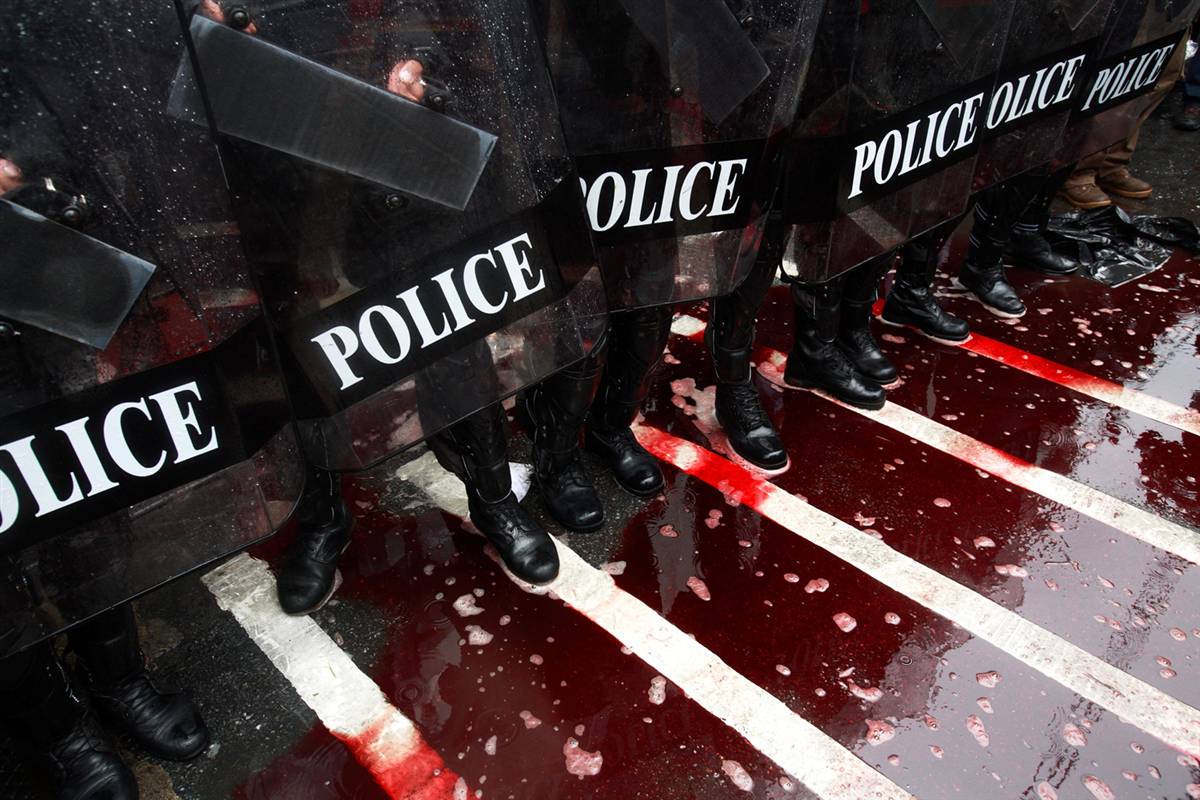
On the Rise of the Right-Wing Mass Movements, Winter 2013/14
After nearly three years of repression, the cycle of revolt that began with the Arab Spring in 2011 has met its winter on the Ukrainian steppe, in Italy’s mountainous north, and on Thailand’s Chao Phraya floodplain. This winter sits now at its pivotal solstice. It’s unclear if it will spread and, if so, how far. What is clear is that the left-wing mobilizations of the early 2010s have each been systematically suffocated, with most as of yet unable to consolidate many substantial gains. Even in Egypt, the heart of the last sequence of struggle, the revolution still sits in a violent gray area, with leftist militants drawn into alliance with the police and the military. As a member of the “original” Egyptian Black Bloc made clear in a recent interview:
After a while, these fake Black Bloc members even started negotiating with the head of police and the Minister of Interior, and they agreed to work together against the Muslim Brotherhood. Even friends of mine were involved in this, they said that now the army and police were on their side and that they would give us justice. They were traitors to the revolution and traitors to our friends who died. They forgot about everything we fought for.
In Greece, Golden Dawn made international headlines after gaining six percent of the vote in 2012. And Golden Dawn itself is only the most prominent of many revanchist parties sprouting up across the EU, most of which have, since the crisis, been capable of winning small but significant electoral victories while recruiting angry, white crisis-era youth into their ranks. But Golden Dawn and most other European far-right organizations, such as the French National Front or British National Party, though capable of gaining some seats in parliament and often attempting to intervene in recent political turmoil, have ultimately been incapable of leveraging the austerity-era struggles in their favor.
In the past few months, however, all of this has changed. In Italy and Ukraine, we have seen far-right movements gain a limited mass base—not only exploiting political faultlines to their benefit but actually calling new, if limited, mass movements into being. And in Thailand the monarchist and nationalist right-wing has broken the détente established in 2011, again mobilizing its base into a series of anti-government protests that may in the near future result in another coup—protests that, more importantly, have been explicitly mimicking the appearance of the past few years’ left-leaning occupations and blockades.
If this is, indeed, an “age of riots,” what does it mean when those riots turn to the right? Is this an isolated phenomenon, set to be overcome by a more forceful, second wave of left-wing resurgence? Or is this the earliest prefiguration of repression’s frightening future, in which structural fissures between fractions of the class are split into gaping, seemingly unbridgeable chasms, in the form of caste, race, nation or law-abiding-citizenship?
Recently, the age of riots thesis has been recast in terms set by Marx in the middle of the 19th century:
The ‘League’, like the société des saisons in Paris and a hundred other societies, was simply one episode in the history of a party that is everywhere springing up naturally out of the soil of modern society.
The quote is from one of Marx’s letters to Ferdinand Freiligrath, dated 29 February 1860, and refers to the “experiences of 1848-52,” specifically the revolutions of 1848, and the formation and disbanding of the Communist League. This letter is the basis for the contemporary notion of the “historical party,” which, in the words of Gavin Walker, designates “the party as a line of resistance that emerges out of the movement of capitalist society,” with the formal organization only existing as one “episode” in this larger party.
The historical party, then, is a name for the sum of struggles produced by class dynamics at a given moment—specifically when those struggles finally reach a certain escape velocity. After this, they kick off more frequently and spread to new locations more easily. They also intensify more quickly, with no one quite sure when the next police killing might erupt into a multi-city riot. The Arab Spring clearly marked the rebirth of such a party—and we can think of the “age of riots” as roughly equivalent to this party’s reemergence.
But what does it mean for the historical party when its own dynamics turn far rightward? Did the historical party disappear under repression? Has it ceased to “spring up naturally?” Or has its “natural springing up” been somehow deformed? And, if we don’t include these new right-wing movements in the “historical party,” where, exactly, has that party gone? And what has taken its place?
Euromaidan
Probably the most widely-covered of the recent right-leaning mass movements has been Ukraine’s “Euromaidan,” a sequence of protests, blockades, and riots that began in November of 2013 and continued into the new year.
A number of things are unique about the Ukrainian protests. First, contrary to the anti-EU attitudes of the right-wing revanchist parties in the rest of Europe, the Ukrainian protests are strongly pro-EU, having been kicked off by the Russia-leaning government’s decision to suspend the signing of a key “Association Agreement” with the Europe. This brought together a wide array of people, and by no means are the majority of them right-wing or even necessarily sympathetic to Ukraine’s far right groups. Nonetheless, these far-right groups have been playing leading roles in the opposition movement, to the extent that even moderate forces have taken to repeating their nationalist chants during political rallies.
Second, the protests are not clearly pitting right-wing forces against left-wing ones, but instead making visible pre-existing schisms between Ukrainian elites and their various factions. The competition has been between pro-EU and pro-Russian forces, and there are far-right supporters at the core of both. What’s more interesting has been how the nature of the protest movement has brought plenty of moderate, liberal groups, student organizations and NGOs into a large pro-EU coalition with active and prominent participation by groups like Bratstvo, a self-described[1] “‘Christian Orthodox national-anarchist” organization, and Svoboda, an anti-communist nationalist party with ethnically-exclusive membership. The protestors themselves, coming from many backgrounds, are acting as the motive force here, and these far-right groups have thus far been successful in fusing with and leading that force rightward.
More importantly, this right-wing populist movement comes nearly ten years after the progressive Orange Revolution of 2004/2005, which failed to substantially improve the situation of most Ukrainians, particularly its student and worker social base. The Orange Revolution, similar to the recent left-wing mass movements in Europe and the US, brought together groups across different social strata, mobilizing people in a left-populist protest against political corruption and raising hopes of a widespread economic and political reform that never materialized. It is on this terrain—the failure of social democracy and left-wing populism—that the reactionaries have begun outmaneuvering the combined forces of the left.
Finally, the character of these far-right groups is worth noting. Organizations like Bratstvo are national-anarchist, combining the aesthetics of the left with an essentially right-wing politics. They utilize public spectacles and trumpet anti-imperialist language reminiscent of the anti-globalization era. Groups like Svoboda, though beginning as run-of-the-mill European far-right organizations, have since undergone a massive PR makeover, crafting an image of “respectability” in an attempt to gain greater appeal.
Svoboda grew out of the Social-National Party of Ukraine, which emphasized its ethnic restrictions and branded itself with runic imagery similar to that used by neo-Nazi groups in Western Europe. Today, the Nazi-style aesthetics are gone, replaced with an Guy Fawkes masks and an Anarchist-looking red-and-black flag representing “blood and soil.” Similarly, in 2004 the party adopted a new political program, disaffiliated from their paramilitary organization (effectively re-composing it as a separate organization), and retooled their nationalism from a narrow ethnocentrism (such as imposing tiers of citizenship based on ethnicity) to a broader anti-immigrant platform that tended to poll better. All of this, combined with the power vacuum created by the break-up of the ‘Orange’ social-democratic political faction, has led to a situation in which such parties are becoming less and less marginal.
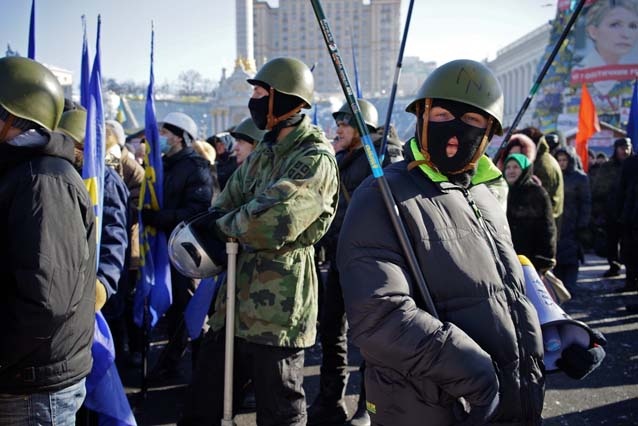
Here a member of the protestors’ Splina security group is seen sporting the old symbol of far-right party Svoboda
At the same time, the situation in Ukraine is still very much up in the air. The right-wing has not succeeded in entirely consolidating the movement around itself, despite the extent to which its messaging, imagery and tactics have been generalized. As new members pour into the occupation, it is just as likely that a stronger force might emerge capable of both opposing the Russian-backed government of Yanukovich and the right-wing segments of the opposition movement itself. This becomes increasingly possible as more and more of Ukrainian society is polarized around the event and drawn into its consequences. At the moment, however, the right wing still appears to be in ascendance.
Stars and Pitchforks
In Italy, we find a similar situation, though one in which explicitly far-right groups have played a slightly more subdued role. The recent Pitchfork protests, combined with the rise of the Five Star Movement (MoVimento Cinque Stelle, or M5S), has nonetheless signaled a major right-wing resurgence in the country, concentrated in its northern cities. Though at the moment less insurrectionary than the Ukrainian Euromaidan, the new Italian populism has made serious electoral headway, and has basically monopolized the Italian anti-austerity movement.
More troublingly, Micah White, a wingnutty Adbusters editor who was one of the “originators of the Occupy Wall Street meme,” has recently been touring the US to advocate that activists here form a similar “beyond left and right” populist party based on the M5S in Italy—and organizationally meshed with it as a single international party. Though White is clearly an outlier, there are more than a few similarities between the new Italian movement and our domestic wingnut populism a la Infowars, Alex Jones and Rand Paul. Some of these forces were present in Occupy early on, often in the form of “End the Fed” protestors and younger, conspiracy-theory techie-libertarians.
When we look more closely at Italy, we find many of the same features noted in Ukraine. The far-right forces, like CasaPound, Tricolour Flame, and Forza Nuova have all undergone PR transformations in the last decade, abandoning 20th-century Fascist aesthetics in favor of a softer nationalist imagery that actively mixes in vital elements of the anti-globalization era, the Movement of the Squares and Occupy. M5S commonly uses the Guy Fawkes mask and other V for Vendetta symbolism in its campaigns, the exact same symbols favored by the right-populist segments of Occupy. Similarly, CasaPound began in a squatted building, one of many right-wing social centers that mimics the infoshops and squatter encampments common to the anarchist left.
In terms of political content, we again see a similar merger of left and right—or, more accurately, the use of left-wing aesthetics, slogans and postures as a superficial veil obscuring an essentially right-wing politics. TriColour Flame, for example, is third positionist, upholding a revolutionary nationalism opposed to both communism and capitalism that frames itself as “beyond left and right” while drawing inspiration from Italian Fascist history. M5S mixes conspiracy theory, anti-globalization rhetoric, anti-immigrant diatribes, condemnations of political corruption and populist appeals to the Italian People into a seamless mush of substanceless, right-wing vitriol.
Such groups have been marginally successful at forging coalitions with Italian student groups, NGOs, football ultras, farmers’ organizations and protesting truckers, though they’ve failed to cohere the general movement around their initiative as thoroughly as the right-wing groups in Ukraine. At the same time, they’ve been the ones leading blockades of Italy’s major logistics centers and attempting to escalate the movements’ tactics, essentially gaining a monopoly on the Italian anti-austerity movement without any significant challenge posed by Italy’s left.
Full Circle
In Thailand, the country that the majority of this analysis will be dedicated to, we are now seeing the rise of a similar right-wing mass movement, but one that is in many ways far more advanced than those of Ukraine or Italy, with its own bloody history and entrenched political commitments.
In one sense, it’s fitting that Thailand is where such a movement is now emerging, since the left-wing Red Shirt occupation of Bangkok in 2010 directly preceded the squares occupations in North Africa and Europe, though western commentators often do not include it in the same lineage. Like these Occidental revolts, the 2010 occupation very nearly became an insurrection and civil war, but (unlike its Egyptian counterpart) it was violently crushed before the regime could be overthrown.
Now, the pattern has come full circle. The current anti-democracy protests are a distorted mirror image of 2010. At the same time, they parallel the heyday of 2006 when a conservative mass movement last mobilized across Bangkok providing a middle-class support base for the subsequent military coup against a popularly-elected government.
Thailand is also one of the few places where national-anarchist and effectively third positionist far-right organizations have had significant time to build up a social base, obtaining limited backing from the monarchy, historical backing from the US military, and intellectual justification from the country’s “radical” intelligentsia. Some of these organizations, such as the Buddhist Santi Asoke group, are authentically anti-capitalist, utilizing leftist language and tactics, promoting autonomous self-governance and the rejection of international financial institutions like the IMF, all within the framework of a socially conservative, ethnically nationalist and neo-feudal political-economic program. Many of these groups draw their leadership from both the far-right paramilitaries of the 1970s as well as leftist NGOs, which often include demobilized Communist Party of Thailand (CPT) cadre. They thus represent not only the combination of leftist political imagery with a rightist core, but also the limited fusion of Thailand’s left-wing and right-wing histories, with the latter subsuming the former.
As I write this, increasingly violent anti-democracy protests are underway in Bangkok, led by the “People’s Democratic Reform Committee” (PDRC), whose Thai name more accurately translates to the “People’s Committee for Absolute Democracy with the King as Head of State.” Prior to the official formation of the PDRC, the protests had cohered around the far-right Pitak Siam (“Protect Thailand”) Organization, which sought to re-unite the dispersed forces of the yellow shirts who had led the coup in 2006.
The PDRC now plays this role, having drawn together many of the 2006 coup’s original supporters. Among the vocal leaders of the movement are Democrat Party MP, Suthep Thaugsuban, who, after his party again lost national elections to the populist Pheu Thai Party (PTP), resigned from parliament to lead the protests. In 2010, Suthep was director of the Centre for the Resolution of the Emergency Situation (CRES), which was the governmental body that allegedly ordered the military to crack down on the Red Shirt occupation using live ammunition, killing nearly a hundred civilians and injuring thousands. Organizationally, the PDRC is in the direct lineage of the “People’s Alliance for Democracy” (PAD), otherwise known as the “Yellow Shirts,” who facilitated the 2006 military coup.
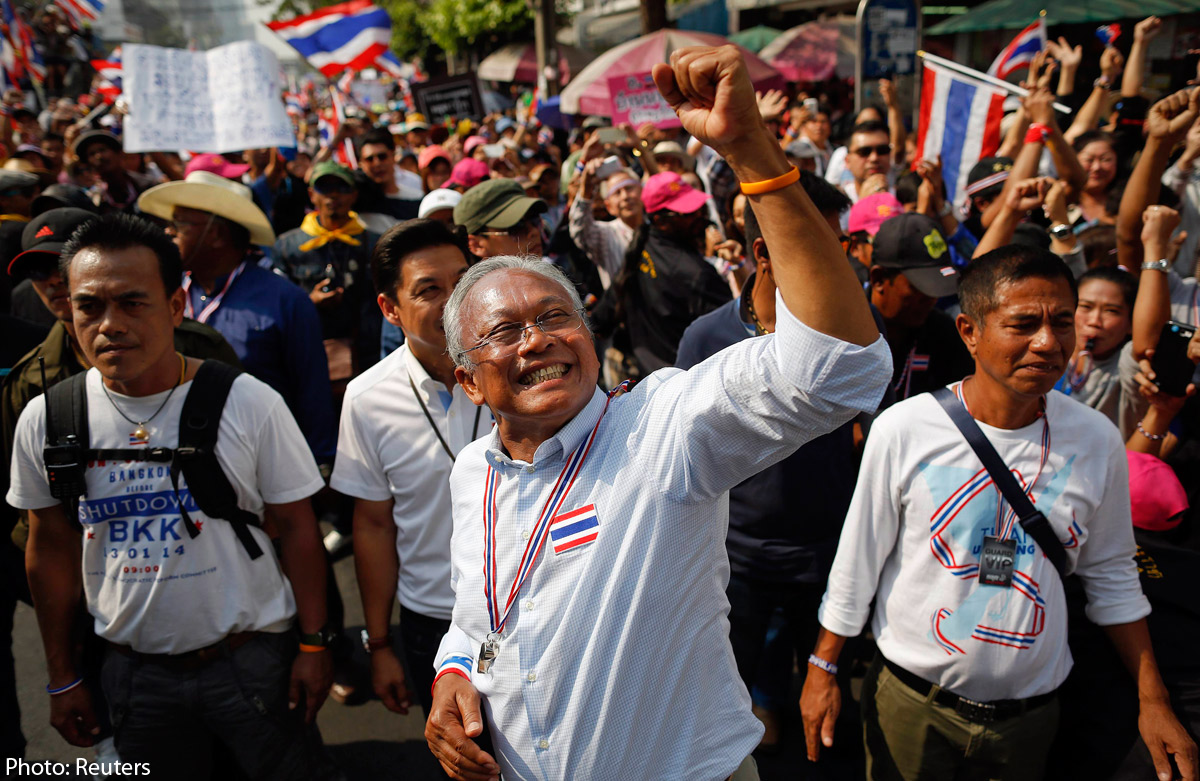
Protest leader Suthep Thaugsuban, leader of the current protests. In 2010, Suthep gave the order to use live ammunition against largely unarmed Red Shirts protesting an unelected military-backed government.
Ramping up in November, the anti-democracy protests have since drawn tens of thousands of supporters to their largest rallies, though their own media (falsely) claim that people are participating in the millions. A survey by the Asia Foundation estimated participation in one of the biggest events in November to total out at around 24,000, spread over several rally sites (see pg. 2 of the report). Since then, numbers have waxed and waned.
The survey also confirmed that the income levels of the anti-democracy protestors (versus the Red Shirt counter-protestors), were generally higher, they had higher educational attainment (with a majority holding a bachelor’s degree or above), more of them were from Bangkok or Thailand’s south, and their occupations tended to be of a more middle class, professional character, with the majority reporting that they were “executive or managerial,” “businessmen/self-employed,” “government staff,” a “sales or office worker,” or a “small business owner” (see pg. 6 of the report). This is contrasted with the Red Shirts, whose supporters were predominantly farmers and workers, though they also included many small business owners, sales or office workers and government staff.
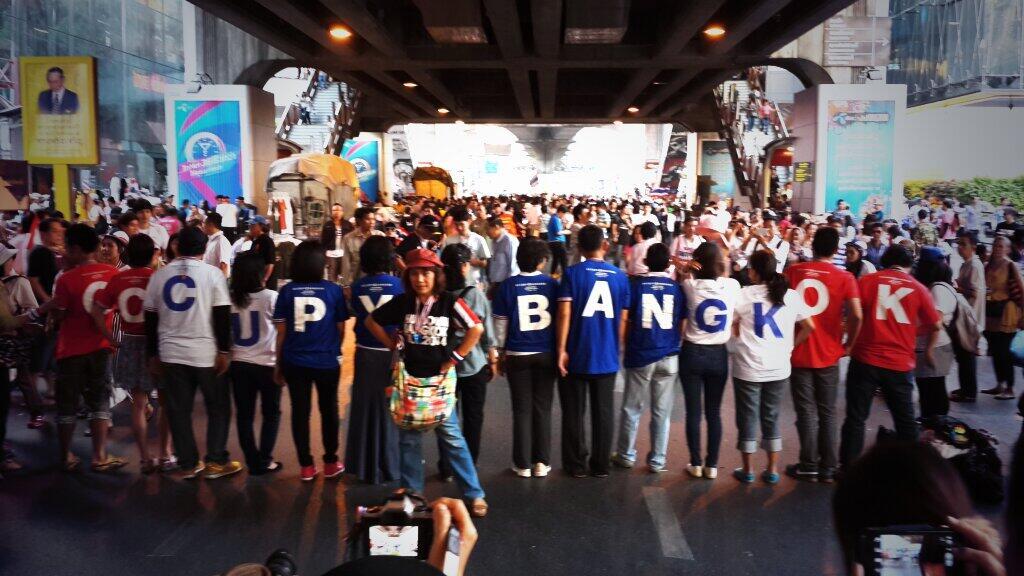
Using the language of recent left-wing movements, anti-democracy protestors call for supporters to “Occupy Bangkok” in the winter of 2013/14 in order to replace parliament with an unelected reform council appointed by the military and the monarchy
Since that report was released, the PDRC has called for a “Bangkok Shutdown,” styled after the 2010 Red Shirt occupation (and focused in Ratchaprasong, the same area of Bangkok occupied by the Red Shirts), but also specifically mirroring the language and imagery of the Occupy movement in the US. Though participation seems to be much smaller than the Red Shirt occupation four years ago, the attendance has still been significant, and is representative of much more general divisions cutting across Thai society.
So what accounts for the rise of this relatively large and explicitly anti-democratic mass movement, based among the urban middle class? And how has it reached the level of militancy and organization that it has, despite lower participation than competing Red Shirt mobilizations? To answer these questions, we have to first overview the rise of the current Yingluck government, opposed by the protestors—and it is impossible to understand Yingluck without first understanding her brother, Thaksin Shinawatra.
“A Country is a Company” – Thaksin and the Corporal State
Thailand is a country marked by a sharp rural-urban divide, with a poor rural hinterland, particularly in the Northeastern Isan region, providing a cheap source of both agricultural resources and migrant labor for the wealthier urban core. It’s also a country with a deeply divided ruling class, with factions tied to the military and the crown (which is the largest single landholder in the country and the richest monarchy in the world), others tied to run-of-the-mill neoliberal interests, and still others having turned (after the Asian Financial Crisis of 1997/98) to a populist quasi-Keynesian capitalism. Each class fraction also frames its particular model of exploitation in anti-Western, anti-imperialist rhetoric, contrasting the decadence and corruption of the US-backed global economic order with the virtue of King and Nation. Power shifts generally signal some further fracturing of this ruling class or a shuffling of its allegiances. And such shifts occur with relative frequency: Thailand has experienced more coups than any other country in modern history.
As Federico Ferrara, a Thailand scholar based in Singapore, writes of the recent division between red shirts and yellow shirts:
As they have for the past eight decades, if perhaps in terms that have never been more stark, the Thai people face a choice that offers no real alternatives. Before them stand two factions, divided more by competing private agendas than alternative visions for the future of the country. On one side, in yellow, safely ensconced behind their tanks, their guns, and a frenzied, yah bah-powered army of street thugs, are the big men drawn from the country’s bureaucracy, the army, and parts of Bangkok’s rapacious business community. These are the people who have ruled Thailand for much of the past 75 years, under the pretense of protecting the country’s most sacred symbols
[…]
On the other side, in red, stand the big men of a different kind—provincial gangsters, corrupt upcountry politicians, and Bangkok-based businessmen who have fallen from the grace of the military and bureaucratic elites. They too want the whole pie for themselves. They too have used public office to line their own pockets, reward their cronies, and silence their critics. […] The difference? Instead of viewing them as a threat, the red shirts see the people as an opportunity. Instead of telling them, to their face, that they have no right to a government that works for them, they seek to ride the people’s long-frustrated aspirations all the way back into executive office.[2]
But throughout all this, the Thai people themselves had not been silent. After the bloody crushing of the social movements of the 1970s and the subsequent defeat of the Communist Party’s attempted guerrilla war, the most significant grassroots organizing in Thailand emerged in the 1990s with the Assembly of the Poor (AOP). The AOP grew in tandem with an explosion of civil society groups and NGOs filling the service gaps left by the exterminated communist movement. These groups, however, made efforts to distance themselves from communist goals, and, like “civil society” in many Asian countries, often received indirect funding from wings of the US government.
The AOP developed in this climate, combining leftover experience from the disarmed communist movement with a nineties-style focus on direct democracy, horizontalism, and social justice. But, like their Seattle ’99-era counterparts in the West, even their most radical actions were largely geared toward petitioning officials and, failing at this, pressuring them by drawing attention to social issues through staged media spectacles. The AOP also utilized some minor blockade and strike tactics, but always with more of a focus on media attention and policy change, rather than actual disruption and dismantling of the dominant economic structure.[3]
During this time, there were also attempts to bring this populism into parliament. Early on in his political career, Thaksin Shinawatra had been a member of Chamlong Srimaung’s explicitly Buddhist Palang Dharma Party (PDP), which ran on a “get money out of politics” platform of electoral reform. He also worked closely with Buddhist group Santi Asoke, offering funding for them to run organic farming schools in the countryside. After he gained leadership of the PDP in 1995, the party was torn apart by internecine conflict between the secular “pragmatist” faction, headed by new business elites like Thaksin, and the Buddhist “temple” faction, which ostensibly rejected the role of money in Thai politics and was led by traditionalist religious devotees like Chamlong who projected an image of thrift and moderation.
This split in the country’s populist movement in the late nineties would signal an important pre-figuration of the future divide between the red shirts and yellow shirts after the 2006 coup. Though they had shared common roots and an often similar populist perspective, there was always a tension at the heart of their alliance.
After the tearing apart of the PDP, the Asian financial crisis hit, and Thaksin was one of Thailand’s few millionaires to emerge from it unscathed. Largely unopposed after the crisis, he began building a coherent political base in the countryside concentrated around his left-populist Thai Rak Thai (TRT) party. Against the vicissitudes of neoliberalism—long observed by Thai peasants but made nationally apparent by the crisis of the late nineties—Thaksin advocated a revitalized Keynesian development model for the country, investing in schools, basic transportation and agricultural infrastructure, as well as instituting a universal public healthcare system that made medical facilities readily available to many peasants for the first time. His government also engaged in direct monetary stimulus, loaning villages a one million baht fund to encourage the founding of small businesses.[4] Where groups like the AOP could only hope to influence the margins of certain investment policies, TRT offered peasants the chance to vote for large-scale reforms that promised to create real and immediate changes in their lives.
Thai Rak Thai immediately took off, fundamentally transforming the nature of Thai parliamentary politics in the post-crisis era with its focus on infrastructural investment and national, policy-based campaigning, rather than simply buying votes through the standard provincial networks. This played off populist energies while simultaneously bolstering the power of Thaksin and his particular fraction of the Thai ruling class. As Chris Baker and Pasuk Phongpaichit argue in A History of Thailand:
In part, [Thaksin’s policies] provided improved welfare, especially a universal health care scheme. In part, these were schemes to extend capitalism down to the roots of the economy, transforming semi-subsistence peasants by better access to capital and markets. But Thaksin’s populism was not only a matter of policies. He cultivated a public presence and mass popularity in a manner totally new for Thailand’s political culture. (p. 266)
Thaksin’s vision of populism, then, was in many ways fundamentally different than that of his “temple” faction counterparts. Whereas they sought a return to Buddhist tradition for the countryside, Thaksin’s populism was corporatist, envisioning an extension of political powers downward, the purging of the inefficient bureaucracy and the productive integration of the peasants into a modern economy which itself was a competitive unit in a global capitalist system. Though all of this was to be facilitated by Bangkok’s new business elite, it was fundamentally driven by the initiative of peasant smallholders-cum-entrepreneurs.
Baker and Phongphaichit go on to detail Thaksin’s own vision of his political project:
Thaksin promised not just to extricate the economy from the crisis, but to leapfrog Thailand to first-world economic status. Principally this would be done by transforming the torpid bureaucracy into a support system for private enterprise. Thaksin stated that ‘A country is a company. The management is the same.’ […] Thaksin called himself a CEO prime minister, and bestowed the same prefix on provincial governors and diplomats who were summoned for retraining in their new role as promoters of economic growth. A programme for privatizing state enterprises was launched. Government financial institutions were ordered to provide credit to priority sectors and chosen firms. (p. 266)
Right-wing populism today, in the US and elsewhere, generally advocates the devolution of state power to myriad local or regional decision-making bodies, all guaranteed by the renewal of binding myths of national or racial unity and the active instigation of often deeply parochial communitarian projects at the micro-level. At this point, however, such projects have amounted to little more than an ideological smokescreen covering all-too-familiar neoliberal plundering. In Thailand, things are starkly different. This right-wing populism exists in various monarchist, traditionalist and anarchist guises, and it holds much greater sway than equivalent projects in the US or anywhere in Europe.
At the same time, a populism of entirely different character exists in the figure of Thaksin. This populism can, in many ways, be described as left-wing, since it does seek the resurrection of generalized social welfare programs and the direct implementation of quasi-Keynesian stimulus policies, any one of which would outdo the sum total of all the projects even attempted by American progressives in the last decade, whose biggest stimulus has come in the form of MoveOn.org e-mails and print-on-demand Elizabeth Warren hoodies.
But Thaksin’s welfare state was no simple, Thai-style replication of Johnson-era liberalism. Nor was it just right-wing populism in disguise. Right-populists aim to hollow out the state and fill its shell with balkanized power structures loosely linked together above a writhing miasma of private firms competing for territory with localist communitarian projects and new authoritarian city-states—and all fused through some founding myth of nation, king or race. Thaksin’s populism, by contrast, aimed not to hollow out the state, but to corporatize it—to give this spectral, technical apparatus an organic body by raising the communitarian ethic all the way to the boardroom, and the boardroom to the helm of the state.
More importantly, Thaksin positioned his project such that it rode a tide of discontent and authentic grassroots organizing. This enabled him to consolidate the gains of the anti-globalization movements of the 1990s in a fashion that the Democrats in the US were never able to do, even after a decade of anti-summit and anti-war protests radicalized an entire generation before spitting them back out into non-profits, city governments, academic institutions and ever-shrinking labor unions.
By the time that the red shirts emerged, however, this tide was already beginning to decouple itself from Thaksin and the Corporal State.
The Red Shirts: Pre-History of the Squares
Even though the United Front for Democracy against Dictatorship (UDD), commonly known as the red shirts, originally formed in defense of the recently-deposed Thaksin, it would be a mistake to conflate the two.
It is not an exaggeration to say that the Red Shirts represent the largest direct mobilization of Thailand’s poor—worker, peasant and smallholder—since the communist movement of the late 1970s. Yet this mobilization is, nonetheless, ambiguously tied to the figure of Thaksin and his vision of an extensive, corporate Thailand capable of competing in the global economy. And this is not a simple case of co-optation or corporate trickery, but instead a contradiction embedded in the most basic dynamics of the movement itself.
Giles Ji Ungpakorn, a Thai socialist living in exile after having been found guilty of lèse majesté (insulting the king) for criticizing the 2006 coup, uses the metaphor of a “parallel war” to describe the phenomenon:
One way of understanding the “dialectical” relationship between Thaksin Shinawatra and the Red Shirts democracy movement is to borrow the concept of a “parallel war” from Donny Gluckstein’s book on the Second World War. According to Gluckstein there were two parallel wars against the Axis powers. One was an imperialist war, waged by the ruling classes of Britain, the United States and Russia for their own interests, while the other war was a people’s war against fascism, waged by ordinary working people, many of them socialists.
The two wars often overlapped in the minds of millions, but their aims were very different. We can see a kind of “parallel war” in the Red Shirt/United Front for Democracy against Dictatorship (UDD) struggles against the military-royalist elites, where thousands of ordinary Red Shirts struggled for democracy, dignity and social justice, while Thaksin and his political allies waged a very different campaign to regain the political influence that they had enjoyed before the 2006 coup d’état.
Though the UDD formed in direct response to the 2006 coup, fighting the subsequent administration’s attempt to repeal Thaksin’s most popular social welfare programs, it simultaneously grew out of a popular movement that went far beyond the reinstitution of Thaksin, his political allies, or even his welfare policies—a popular movement that was violently crushed in the summer of 2010.
Baker and Phongphaichit echo Ji Unpakorn:
Thaksin was also swept along by a new force bubbling up from below amongst those hitherto excluded from political access, especially those in the neglected agricultural sector and its diaspora of rural-urban migrants. They had been politicized by the agitational politics of the 1990s, by the new access to public space in the media, and by the strains of the 1997 crisis. (p. 273)
The immediate formation of the UDD, which began to cohere this “new force,” was followed by a back-and-forth holding pattern punctuated by electoral victories, legislative coups, and violent battles with supporters of the People’s Alliance for Democracy (PAD), otherwise known as the yellow shirts—who are the immediate precursors of the right-wing protests happening today. Opposition to the military’s 2007 constitution finally coalesced with the public outing of the identities of several key players in the 2006 coup, combined with a call by Thaksin for a “people’s revolution” to overthrow the aristocracy-backed government of Abhisit Vejjajiva. Red Shirt protests increased in 2009 in Bangkok and Pattaya, followed by a parallel increase in military and vigilante violence, leaving hundreds injured and a number of protestors dead.
It was not until 2010, however, that the “people’s revolution” took a form more befitting its name. Early 2010 saw a reform of the Red Shirts’ internal structure and a leap in its outreach activities. As described by Claudio Sopranzetti, in his Red Journeys: Inside the Thai Red Shirt Movement:
[…] the UDD was completely reorganized by rebuilding its local branches, extending its presence in rural Thailand, and training its members. More than 450 “Red Shirts’ Schools” were opened all around the country to develop and foster the UDD local chapters and popular outreach. Early in 2010 a number of protests were held in big cities in Isan drawing thousands of people, yet almost completely unreported in national and international news. (p. 24)
In March, the UDD demanded new elections.[5] They sponsored a “Million Man March,” coordinating the transportation of thousands into Bangkok from the countryside in what amounted to “the largest popular protest in Thai history to date” (Sopranzetti p. 24). These protests, originally centered on Phan Fah bridge, had by April shifted to Ratchaprasong intersection, one of Bangkok’s busiest shopping districts. A state of emergency was declared on the 8th of April, with a deadly massacre following two days later when the military tried to suppress another protest at Phan Fah, resulting in twenty-four deaths and over eight hundred injuries. After this, the besieged protest zone raised barricades and posted guards. Many camped inside while hundreds of others arrived fresh from the countryside each week. Bangkok’s biggest shopping center was shut down completely as commerce in the area ground to a halt. The military surrounded the occupied zone with tanks. Snipers were also posted on rooftops around the site, soon becoming notorious for both targeted and random assassinations—the most dire of these being the assassination of red shirt “security adviser” Khattiya Sawasdiphol (known as “Seh Daeng”). The crackdown grew harsher, adding forty-one deaths and two hundred fifty new injuries.
On May 19, the military led its final assault, demolishing the burning-tire barricades, clearing the protest site, killing five more and reportedly firing on medical staff who went to the aid of the victims. Afterwards, a series of retributive arsons spread across Bangkok, targeting banks, government buildings and completely destroying the largest shopping mall in Southeast Asia, built on land owned by the monarchy. The military instituted a curfew, arresting, detaining and murdering a still unknown number of individuals.
The Bangkok occupation was marked by many of the same features that would later be noted in the Arab Spring, European Squares movement and Occupy Wall Street. The tactic of occupying the nation’s central commercial hub was the most obvious similarity, but others stand out as well: First, there was the ability of the movement to cut across other divisions in the class, bringing urban workers, peasants, smallholders, skilled laborers, students, housewives etc. all together into the same space. This opened up immense potential for mutual transformation and the free exchange of ideas (in a society where censorship is the norm), while also leaping beyond the limits of the identity- or issue-based campaigns of the ‘90s.
Sopranzetti’s reporting from the height of the occupation repeats images familiar to those of us who participated in Occupy in the US, and echoes similar pictures from Europe and North Africa in the spring and summer of 2011:
People sit on the ground and listen with a less physical participation, surrounded by spaces of commerce and consumption transformed into a truly social space, a new political arena in the city, away from the traditional politics played in the old town […] The atmosphere is calm and joyful, food being cooked, the light dimming, and the usual clapping […] At the same time a funeral is going on a few kilometers away at Phan Fa Bridge, where the people were killed last night […] [Even] the usually silent interaction during a [motorcycle taxi] ride has become something different now. It is part of the protest, part of the political participation, discussing with motorcycle-taxi riders, sources of information, travelers, and carriers. (pp. 28, 29)
In Bangkok in 2010, as much as Cairo, Athens, Madrid or Oakland in 2011, we see people collectively making food, forming discussion circles, organizing defense squads, exchanging books, pamphlets, posters and t-shirts, inventing new hand gestures and auditory signals to assist collective decision-making and defensive maneuvers against the military—all the features that have by now become commonplace signatures of recent mass movements.[6]
Second, the movement, at its most basic level, raised the question of class and class struggle in an era when such topics had been effectively banished from the public sphere. Beyond the simple demographics of the movement, the occupation itself was drenched with the imagery and language of class war and anti-capitalism, with explicitly communist symbolism becoming an increasingly prominent feature of the occupation. Sopranzetti describes a typical example, noting the books being sold by an old vendor several days after the government declared a state of emergency:
The books are about people’s movements, an odd mixture of contemporary radical history presented in the omnipresent radical academic magazine, Fa Diao Kan (Same Sky), classics of Thai radicalism, old books with yellowish pages and the basics of Marxist thought, from Marx himself to Rosa Luxemburg. (p. 27)
The book-seller then offers Sopranzetti his own take on the Thai political situation: “He tells me, ‘This is class war, pure and simple,’ and the problem is not Abhisit but the people above him” (p. 27).
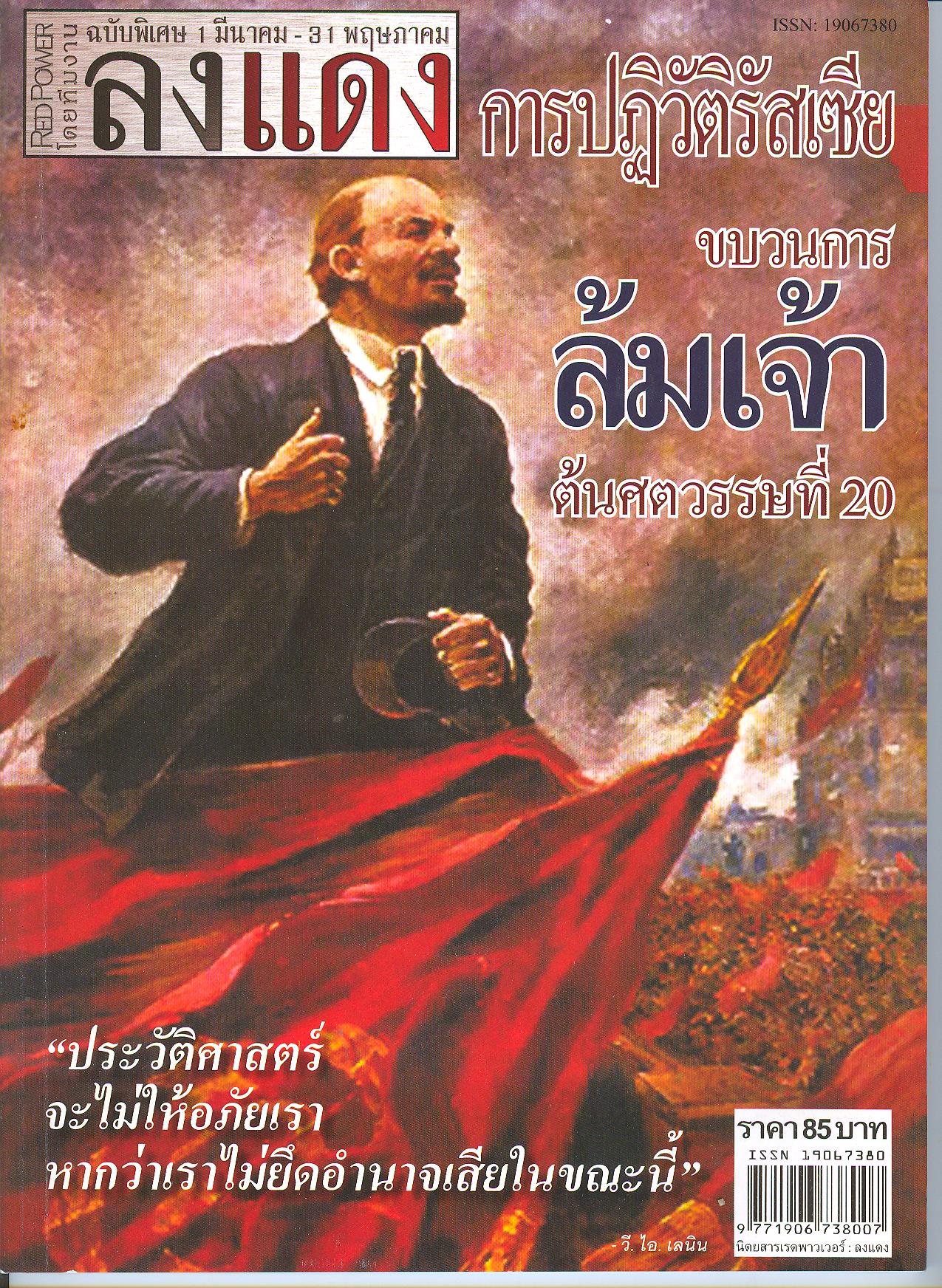
The cover of a special edition of a Special Edition magazine sold at red shirt protests, explicitly drawing parallels between the Russian Revolution and the political situation in 2010. The quoted text on the front is a Thai translation of Lenin’s famous statement: “History will not forgive us if we do not assume power now.”
And such examples were by no means exceptional. Sopranzetti notes similar messages strewn throughout the occupation:
Underneath [a Red Shirt welcome sign], a larger square banner shows a fighter with open hands, in a typical Zapatista representation in stencil. A white inscription “Peasants” (translation of phrai, the Thai word for commoners), stands out in the sunset from the shirt of the speaker.” (p. 28)
In another instance, an artist who frequents the occupation asks him questions about the Communist Party of Italy (pp. 49-50), and another leftist bookseller sports “a green, Mao-like cap with a red star on his forehead” (pp. 50-51) and sells works by Marx and Lenin (p. 52).
The Mao-cap would quickly become a symbol of the Red Shirts’ left wing, loosely associated with “Red Siam,” an explicitly socialist organization attempting to radicalize the mass movement, known for their dual opposition to Thaksin and the military-appointed Yellow Shirt government. The “Red Siam Manifesto,” proposed a common platform of democracy, freedom of expression, taxing the rich to fund a welfare state, non-intervention by the Crown in politics, cutting the military budget, abolishing the influence of the army, reforming the judicial system to operate on public mandate rather than royal appointment, citizens’ direct participation in local government, modernization of education, transport, housing and energy infrastructure, and an end to disputes with neighboring countries.
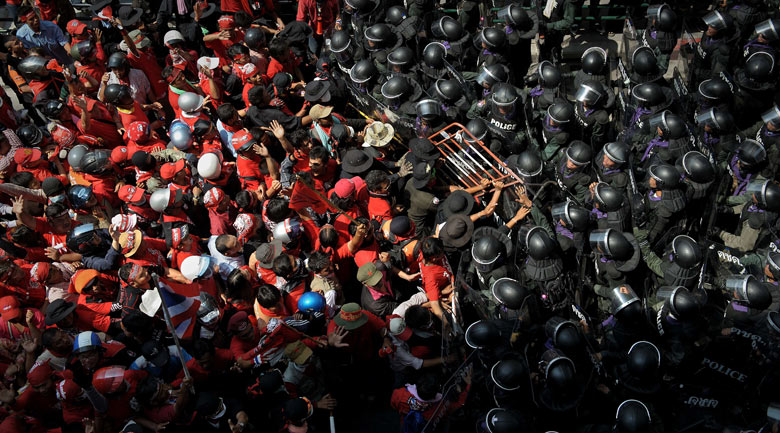
Red Shirts face off against the police and military – note the Mao-cap worn by one of the protestors bottom-center, a symbol associated with the left wing of the movement
Many of these ideas began to permeate more broadly during the occupation, some growing in popularity. Especially notable was the dual opposition to Thaksin and the existing government. The bookseller, when interviewed by Sopranzetti, shares the position: “‘You know, I don’t like Thaksin either,’ he says, lowering his tone, voicing a position that is slowly spreading, ‘but now it is clear Thaksin was just a tool. This is not about him anymore. I didn’t like him. But he had good policies.’” (p. 51)
Sopranzetti also inquires about the prevalence of communist imagery in the movement:
I tell him that I never understood the relationship between red shirts and communist symbolism. The question makes him uncomfortable and he starts to be defensive, maybe as a reaction to years of propaganda equating communists with enemies of the state. ‘Red shirts are not communists,’ he starts out. The Maoist hat on his head seems to disagree. ‘There are some former communists, Maoists, who are in [the] red shirts but they understand that both communism and this movement are about democracy first.’ He seems to lean for a more socialist position, looking at Pridi Banomyong[7] as an example.
Since the crackdown, protests repeated themselves intermittently, though none carried the same character of occupation and economic disruption as the events of April-May 2010. In 2011, a new general election was held in which Thaksin’s sister, Yingluck Shinawatra, won the seat of prime minister on the Pheu Thai Party (PTP) ticket. PTP took the absolute majority in parliament with 265 out of 500 seats, forming a ruling coalition government with several minority parties. After a reshuffling of her cabinet following the 2011 floods, she named Nattawut Saikua (the first leader of the UDD) Deputy Minister of Agriculture, making her links with the formal red shirt “leadership” official.
But Yingluck’s victory was not necessarily a victory for the mass of Red Shirt supporters. As Ji Ungpakorn argues:
[The “parallel war” theory] explains the betrayal of the Red Shirt struggle by Yingluck Shinawatra, Thaksin and their Pheu Thai Party. For anyone doubting the scale of betrayal one only has to look at the issues of lèse majesté, political prisoners and the non-punishment of state officials for killing protesters. The Yingluck government has increased the use of lèse majesté and refused to countenance any reforms of the law or even the justice system.
Lèse majesté political prisoners like Somyot Pruksakasemsuk, Surachai Darnwatanatrakun and Daranee Charnchoengsilpakul (Da Torpedo) languish in jail and their plight as prisoners of conscience is ignored by the National Human Rights Commission and Amnesty International. Even Red Shirt prisoners who were not charged with lèse majesté, but merely jailed for taking part in street protests, are still locked up in the “political prison”. As for the punishment of politicians and military commanders for the cold-blooded murder of unarmed demonstrators in 2010, no significant progress has or will be made.
One of the jailed leaders listed, Surachai Danwattananusorn[8], was also the leader of Red Siam. After the crushing of the Occupation, he left for the countryside to attempt to form a new base of support around an explicitly socialist program. This was apparently enough of a threat to the new “Red” government of Yingluck that she had him jailed for insulting the king.
The initial forces of reaction, then, may have been deeply internal to the movement—a Thermidorean reaction crowned by the event of Yingluck’s election, in which a government rose to power that claimed to act in the spirit of the Red Shirts by prosecuting Abhisit, appointing more conservative Red Shirt leaders to its cabinet, making concessions to the poor through raises in the minimum wage, guaranteed markets for rice, etc., all the while doing absolutely nothing to dismantle the actual economic structures that produce poverty and inequality in Thailand, never attacking the aristocratic powers hidden behind the Abhisit government, nor even challenging the basic institutions of the Thai state. Meanwhile, the left wing of the movement is jailed, its supporters are discouraged from continued protests and its rural base is temporarily sated by guaranteed government prices for rice and an increase in the minimum wage.
Today it’s an open question as to how successful this Thermidor has been. The UDD can still garner major support—according to the count done by the Asia Foundation Survey in November of 2013, the Red Shirt rally in Bangkok actually exceeded the total size of all the anti-democracy protest rallies combined. But it’s unclear how far the decoupling of the people’s movement from the interests of Thaksin and Yingluck has been allowed to extend. If the case of Surachai is any example, the answer may be disappointing. It’s likely that the success of this internal reaction—and therefore the failure of the left-populist movement in Thailand to win any of its real demands—ultimately cleared the ground for this most recent upswing of right-populist protest against yet another Thaksin-affiliated government. So long as the “parallel war” remains parallel, this holding pattern is liable to repeat itself.
The Golden Technocracy
Turning now to this right-wing upsurge, Thailand offers an unparalleled window into the origins, growth and recent development of an increasingly far-right movement with a substantial mass base. In asking whether this movement will be successfully opposed and overturned by the ‘new force’ sitting beneath Thaksin’s rise, it’s essential to explore the character of this right-populism in detail. Thailand, in contrast to Ukraine or Italy, offers an example in which segments of this movement actually held power in recent history, with a significant portion of the current opposition basically in control of the country off-and-on between 2006 and 2011. In addition to this, other key players such as Santi Asoke’s Chamlong Srimuang, have held major political positions in the past.[9] So what are the motivations driving this movement, and what did it do when it actually held the reigns?
Probably the most extensive run-down of the ideology of Thailand’s new right-wing has been composed by Thongchai Winichakul in his essay “Nationalism and the Radical Intelligentsia in Thailand.”[10] The essay details the orientation of this new, ostensibly libertarian populism by exploring its intellectual history and major themes, all represented by the figure of Chatthip Natsupha, who acts as Thongchai’s rhetorical foil. As described by Thongchai, Chatthip
[…] has gone from being a Marxist intellectual in the 1970s to cultural nationalist advocate of a genuine Thai essence which, he believes, is an antidote to the dominance of the [sic] Western neoliberal capitalism. His case is not an anomaly […] The cultural nationalist Thai ex-left rejected what it called ‘bad’ nationalism and embraced a ‘good’ one […] Such nationalism, which is widespread among the Thai intelligentsia, was an important factor in their support for the military coup which, in 2006, ousted an elected government on the dubious grounds that it was a proxy for global capitalism. (p. 575, in abstract)
In examining Chatthip’s turn from left-wing Marxist in the 1970s to cultural nationalist today, Thongchai notes that “Chatthip and his followers have never thought of themselves turning rightwards at all” and, instead of a simple story of leftist-gone-right, “the racial nationalism today evident in the discourse of Chatthip and his disciples is deeply intertwined with their leftist, specifically left nationalist, past” (p. 577). This left-nationalism is founded in the basic thesis, with plenty of overt influence from Subalternists and Post-Colonial theorists[11], that the site of resistance to Western capitalism is in the inherently anarchistic essence of Thai village culture:
[Chatthip] now saw the Thai village—or rather an essentialised, even orientalised, version of it—as the site of resistance to capitalism—or rather to the global, Western, consumerist and materialist civilization which did not have much of a domestic presence in the villages. Subscribing to the dubious notions of the ‘Asiatic mode of production’, Chatthip and his disciples argued that, just as Thai villages were not penetrated by the parasitic Oriental despotic state to any significant degree in the past, they now stood outside the gambit of neoliberal global capitalism and thus, more than any other part of Thai society, had the potential to resist it. (p. 579)
[…]
What made the Thai village, the core of Chatthip’s idea of a progressive—anti-capitalist and anti-state—politics, strong, autonomous, cohesive, self-sufficient and rather anarchistic? Abandoning his prior socioeconomic approach, he found the answer in the ‘culture’ of the Thai peasantry […]
‘Community culture’ refers to the peasant intellect and peasant ways of living […] Community culture allows Thai peasants to live self-sufficiently in harmony and peace, and to cope with challenges from the outside effectively to avoid the perils of the state and capitalist ‘development.’ (p. 581)
Chatthip’s focus on an idealized Thai village mirrors a broader “agrarian myth”[12] that has become increasingly central to right-wing populism in Thailand. Robert Dayley, in his article, “Thailand’s Agrarian Myth and Its Proponents,”[13] explains the basic framework:
Thailand’s agrarian myth is the general belief that small-scale, subsistence farming is the most desirable form of community life for Thai rural families, and includes the following interconnected elements:
• Rural contentedness: a ‘fish in the water and rice in the fields’ imagery of rural contentedness derived from top-down official histories of the 13th century agrarian kingdom of Sukhothai;
• Baan (village community): a bottom-up view of history held among many in the Thai intellectual community that ‘the village community’, or baan, is the central organizing mechanism around which everyday life properly functions;
• ‘Thainess’: a general sense that ‘Thainess’ (khwampenthai) and all things genuinely Thai (thai thae thae) emanate from rural village life;
• Chao naa (farmer peasants): the notion of chao naa (farmer peasants) and similar emic concepts (e.g. chao rai, chao baan, khon chonabot) which statically characterize the rural Thai experience by inseparably connecting people, place, and socio-economic role to cultural identity;
• A ‘sufficiency ethic’: an ethical construction formed by the broad normative use of the concept ‘pho’ (enough), and its close twin ‘phophiang’ (sufficient/sufficiency), which have influenced actual historical experience as well as modern perceptions of Thailand’s own rural past. (pp. 343-344)
Even more importantly, Dayley notes that “these visions come predominantly from cultural elites, bureaucratic planners, military brass, religious fundamentalists, and seasoned intellectuals—who do not support themselves by means of culturally-based, subsistence family farming […]” (p. 343). In short: the myth is not widely held, but one generated by particular segments of society who generally sit higher on the class ladder. Even though it is an agrarian myth, it actually appears to have the most purchase among non-farming, urban residents of the middle, upper-middle and (a certain fraction of the) upper class.
Thongchai echoes the sentiment:
Given the centrality of anti-capitalist, anti-imperialist and kindred themes in the discourse of contemporary Thai cultural nationalism, one should note that it is especially popular among precisely the westernised, consumerist, materialistic and even capitalist sectors of society. Indeed, it practically seems to be their spontaneous ideology. This is less paradoxical than it may seem. Whatever the original intellectual impulses behind Chatthip’s and his colleagues’ work, the various themes which they wove together in their discourse about Thai-ness have resonated because they fulfill critical ideological needs of neoliberal times. Their anti-capitalism is at the same time a longing to assert their Thai-ness, or at least their appreciation of it, at the very moment when they seem to have lost it completely. The anti-imperialism can be convenient when one does not wish to identify causes of problems closer to home such as the domestic capitalist class. The anti-statism is, of course, particularly useful in neoliberal times: the poor Thai peasant can conveniently be portrayed as too upstanding to need state handouts (and those who do need them can conveniently be portrayed as not authentically Thai). Finally, of course, like all discourses of the national character, they can always be deployed against alien influences and ideas—whether about democracy and human rights, socialism or feminism. (p. 586)
These views also often mesh with the position of the monarchy itself. In the months following the Asian financial crisis, when public sentiment was steeped in anti-capitalist, anti-imperialist and anti-Western scorn, king Bhumibol Adulyadej, in his annual birthday speech, proposed a “Sufficiency Economy” model of development, contra the “Asian Tiger” model advocated by US-backed financial institutions.
The “Sufficiency Economy” was subsequently fleshed out and a Royally-approved definition was released, which was to set the new national agenda for development:
‘Sufficiency Economy’ is a philosophy that stresses the middle path as an overriding principle […] ‘Sufficiency’ means moderation, reasonableness and the need for self-immunity mechanisms for sufficient protection from impact arising from internal and external changes [… It is] a way of life based on patience, perseverance, diligence, wisdom and prudence […] to cope appropriately with critical challenges arising from the extensive and rapid socioeconomic, environmental, and cultural changes in the world. (qtd.in Dayley, p. 348)
A theory of “sufficiency” development is also espoused by Thailand’s Buddhist fundamentalist factions, such as Santi Asoke, who cultivate their own particular brand of Thai nationalism alongside other monarchists and supporters of the military:
A self-proclaimed radical conservatism has also been influential among Thai intellectuals and activists since the 1980s. Based on liberal and radical interpretations of religious ideas, mostly Buddhist ones, in opposition to the perils of capitalism, consumerism, and the destructive impact of Western culture, it fills the ideological void created by the collapse of the leftist radicals. It promotes popular movements and democracy, as it sees the state as a destructive agent of modern capitalism. Indeed, the radical conservatives are chief among the main forces behind the notion of community culture and its potential to counter capitalism. (Winichakul, p. 585)
This often takes an overtly radical form in practice, with members of Santi Asoke running a national network of co-operative restaurants and shops selling organic products, with some even retreating to rural communes where they
champion an economics of bunniyom (spiritual meritism) in opposition to materialistic capitalism or socialism. They farm organically, produce their own organic fertilizer, keep all property in common, and wear the same style of indigo-colored clothing. Marriage is completely discouraged among adult members and children (adoptees from outside the community) are assigned to ‘parents’. (Dayley p. 350)
The similarities to renewed interest in “back to the land” projects by some US anarchists is notable, especially since they often frame their projects in almost identical language of decolonization and willful subtraction from a hopelessly corrupt capitalist order that stands on the brink of collapse. There is also the obvious similarity to Amish communities, as well as right-wing communitarian visions of a small-town life cohered by a shared religion and culture.
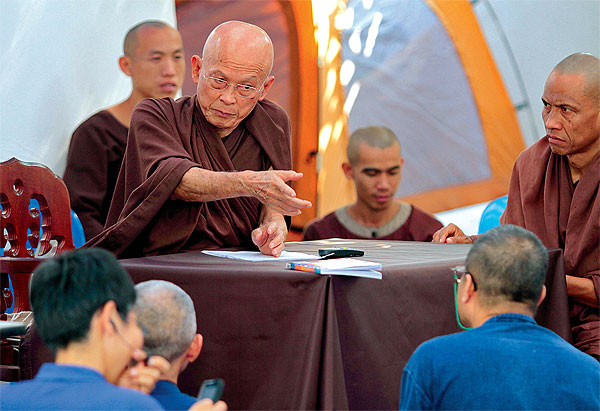
Santi Asoke leader Samana Photirak speaking to supporters and members of the Thai Patriots Network at a rally to protest the Thai government’s “loss of territory” in a border dispute with Cambodia in early 2011. Santi Asoke monks are banned from wearing the saffron robes common to the monkhood in Thailand, since the official Buddhist Supreme Council of the Sangha do not recognize their authority. The Sangha defrocked Phra Phothirak in 2007.
But going beyond their theoretical influence, it’s also clear that these new nationalist projects have the strong backing of certain fractions of the Thai ruling class. The crown, one of the country’s biggest landowners, publicly facilitates Sufficiency Economy programs through a number of state agencies, while at the same time trumpeting the social conservatism and anti-capitalism of right-wing populist groups. The military, likewise, has an overt interest in promoting nationalist projects. And the Sufficiency Economy itself, as a response to the crisis of the late ‘90s, speaks to certain structural limits faced by the migrant-dependent Thai economy. In seeking to duplicate a quasi-feudal system of land and labor administration in the countryside, the plan offered a workable solution to the problem of surplus labor absorption facing the nation after the crisis.[14]
Some of the other opposition forces trace their political allegiance to more parochial concerns, as is the case with media mogul Sondhi Limthongkul, one of the first leaders of PAD (alongside Chamlong). Sondhi was, like many opposition figures, originally a supporter of Thaksin. It was only after Viroj Nualkhair, CEO of Krung Thai Bank, was forced out of his position at the behest of the Bank of Thailand that Sondhi turned against Thaksin and Thai Rak Thai. The reason for his change of heart was simple: Viroj had been Sondhi’s close financial advisor, using his position to forgive 1.6 billion baht of Sondhi’s onerous debts—and Viroj was eventually forced from his position when evidence of his rampant corruption was made public.[15]
Sondhi, alongside Somsak Kosaisuuk and Suriyasai Katasila, would later go on to form the New Politics Party, a far-right party distinct from the Democrat Party, originally intended to be the electoral wing of the PAD. The party chose a Swastika as its symbol—arguing, accurately, that the swastika had a different meaning in Buddhist societies, but still a questionable choice for a party that the Asian Human Rights Commission has labeled “fascist,” noting:
such movements, although they may not describe themselves as fascist, have fascist qualities. Indeed, successive dictatorships in Thailand’s modern history appreciated, expressed and used many fascist symbols and policies, and the residue of these can be found in the language and behavior of the [PAD] alliance leaders today.
Under criticism, the party instead adopted a more stylized swastika image, but retained the yellow-and-green color scheme reminiscent of far-right groups of the 1970s.
By 2006, all of these disparate right-wing interests found their cohering force in the form of the monarchy. As explained by Kasian Tejapira in “Toppling Thaksin,” written for the New Left Review shortly after the coup:
The ranks of the anti-Thaksin forces thus ranged from old-time bureaucrats and officers who disliked the government’s autocratic, CEO style of administration as well as the nepotism and cronyism of its appointments, to business rivals and opposition politicians who complained of unfair treatment at the hands of police, tax or electoral authorities, to conservative technocrats and economists who disapproved of the government’s easy-credit populist social measures, to organized public-sector workers resisting its privatization policies, to community and ngo activists opposing the environmental effects of its infrastructural and energy-development projects, to liberal intellectuals, lawyers and human-rights campaigners who condemned its systematic abuse of power and extra-judicial killings, to critical journalists and broadcasters subjected to government intimidation or outright censorship, to the Malay Muslims in the South, at the mercy of the state-sanctioned terror of the security forces.
Yet the above groups were too diffuse, ideologically and politically, to forge a coherent opposition to the Thaksin government. In the end the only rallying point for these disparate forces was the King. The central demand of Sondhi’s four-month media crusade was a call for the restoration of the Royal Prerogative and the King’s appointment of a new prime minister and cabinet in Thaksin’s place—although, strictly speaking, this would amount to an unconstitutional coup. The ‘Sondhi phenomenon’ drew its legitimacy from the Privy Council-led Thammaraja anti-corruption campaign, in which a broad layer—anti-censorship media activists, anti-statist ngos, anti-privatization trade unions, anti-capitalist development groups—found common cause, as they did with the royal Setthakij pho-phiang (self-sufficient economy) proposals. Despite the controversy surrounding the Royal Prerogative demand, the People’s Alliance for Democracy which assumed formal leadership of the fast-growing anti-Thaksin movement swiftly approved it and put it forward as their own. The movement was thus given a collective royal-nationalist political identity, by defining Thaksin and his regime as the enemy of the nation, the Buddhist establishment and the King.
The People’s Alliance for Democracy (PAD) went on to lead tens of thousands of protestors in marches and blockades across Bangkok under the anti-Thaksin slogan, “Fight for the King.” In 2006, the result was a successful military-backed coup that formally deposed Thaksin—a coup that was silently endorsed by the monarchy.
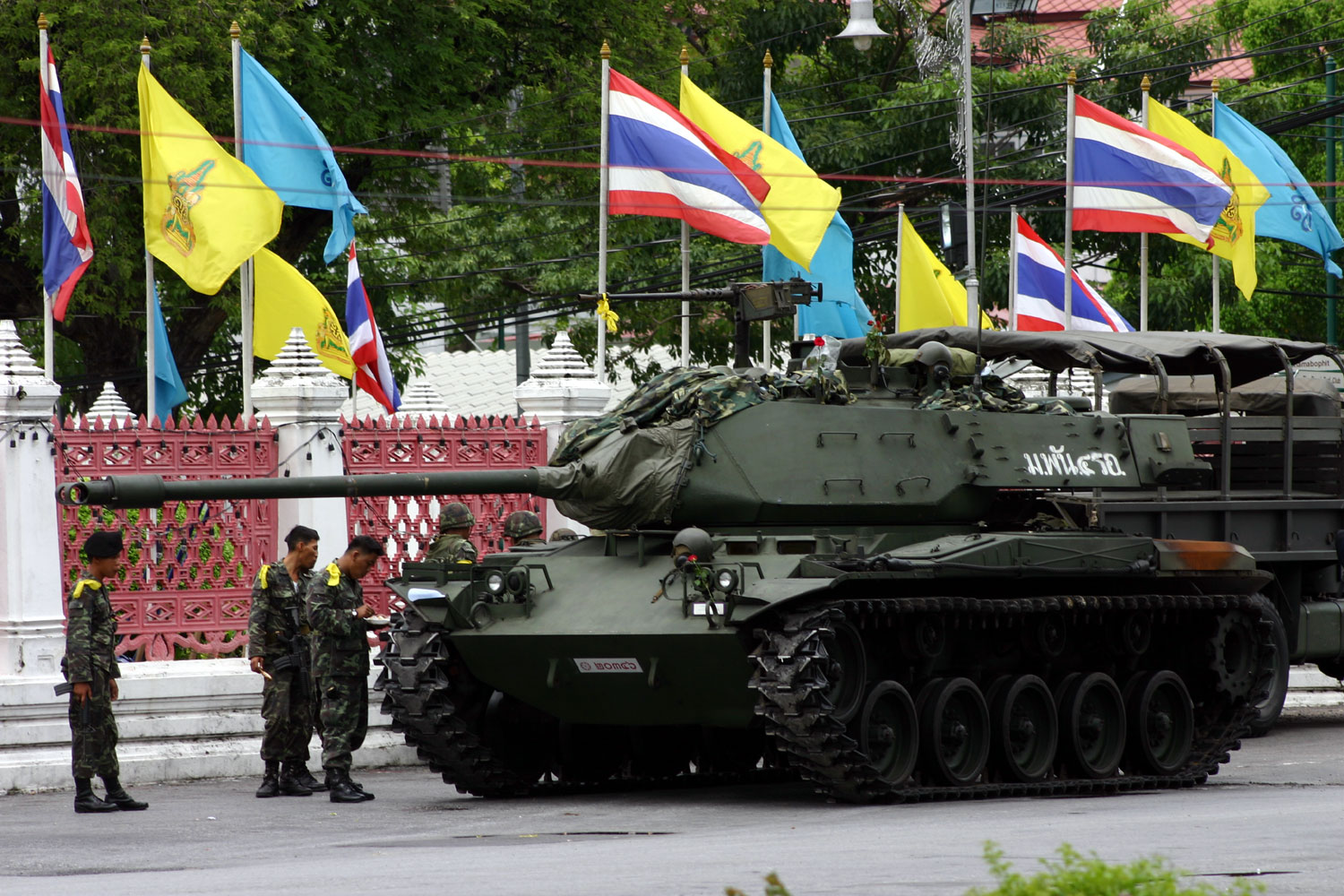
A tank parked in front of a government building after the 2006 coup. Note the yellow ribbons attached to the soldier’s uniforms and the machine gun barrel on the tank—a symbol of the PAD (yellow shirts) and the monarchy. These are largely the same forces leading the protests in Thailand today.
In 2007, Thai Rak Thai was briefly resurrected as the People’s Power Party, with Samak Sundaravej winning that year’s elections. At this point, PAD renewed its opposition efforts, occupying the Government House, closing off parliament, and ultimately blockading Suvarnabhumi International Airport. The aristocracy showed its support for the opposition when Queen Sirikit presided over the funeral of a PAD supporter killed by police. The People’s Power government was soon overturned in a second coup, this time judicial, rather than military. After the People’s Power Party was banned (and the Thaksin-aligned forces thereby prevented from running), a coalition government was elected with technocrat Abhisit Vejjajiva at its helm.
This series of coups between 2006 and 2010 reoriented power within the Thai ruling class. As Baker and Phongphaichit note:
For the army, however, the [2006] coup was a qualified success. The unit commanders who had cooperated in the coup were rewarded with large bonuses from the public purse. Generals returned to the front pages, to the boards of state enterprises, and to other positions of influence. Over two budget cycles, the allocation to the military was raised by almost one half. (p. 271)
More troublingly, many of the forces behind PAD (and behind the protests happening today) traced their histories back to the anti-communist campaigns of the late 1970s. Chamlong, for example, was a former military general and a member of the anti-leftist “Young Turks.” He has admitted to attending rallies by the right-wing “Village Scouts,” and the Young Turks supported the October 1976 coup—also allegedly participating in (or at least endorsing) the 1976 Thammasat University massacre. This disturbing history became an important element of the post-2006 political order:
The model for this project was the post-1976 era, when many of the coup leaders had been involved in controlling the communist insurgency. In their internal documents, General Sonthi’s group imagined that the small number of former 1970s activists in TRT were now spearheading the old communist agenda through electoral politics. On the model of the old vigilante organizations, special army teams were sent into the villages […] to ‘persuade’ people to drop their support for Thaksin and TRT. (Baker and Phongphaichit, p. 271)
[…]
The army pushed for an Internal Security Act reviving ISOC [Internal Security Operations Command] that had directed the anti-communist campaign in the 1970s and 1980s. Despite strong opposition, the Act was passed with minor amendments in the dying days of the coup government’s term. (ibid, p. 272)
Beyond this, the actual management of the country was turned over to a technocratic administration. The military generals wrote a new constitution repealing many of the political rights guaranteed in the 1997 constitution. They filled top political positions with elderly bureaucrats, then, when stagnation became apparent, upgraded to a more modern technocracy headed by the younger Abhisit, who pursued renewed censorship measures, re-nationalized certain industries (effectively turning them over to the control of the military), offered a populist “People’s Agenda” attempting to match segments of Thaksin’s social welfare programs, caused a spike in public debt, and instigated minor border conflicts with Cambodia.
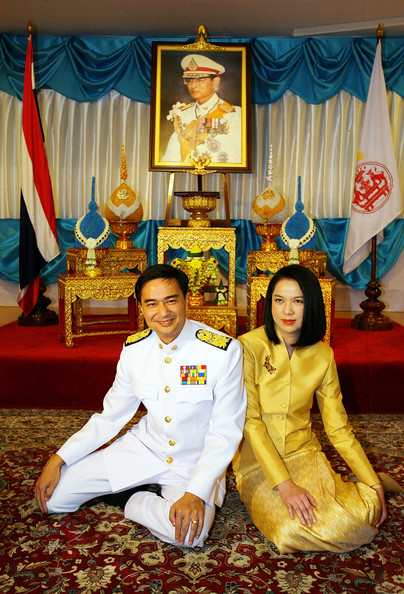
Abhisit Vejajjiva, head of the government after the coup, here seen in military regalia, kneeling beneath an image of the king.
Under his administration, government indebtedness rose 50% and unemployment jumped by 63% as the country underwent a recession. This was subsequently challenged by two major stimulus packages, but the depth of the recession would play an important part in mobilizing the Red Shirts against his regime in 2010. And, in a strange victory for Thaksin, the new government found that most of TRT’s original populist programs simply could not be repealed for fear of mass public opposition. The basic healthcare, education and energy initiatives were largely maintained, though tweaked slightly to better accommodate the Sufficiency Economy model of the king.
When the right-populists actually held power within the last twenty years, then, the result was a paternalistic despotism concentrated around the military, the bureaucracy, and a few well-placed financial and industrial family monopolies centered in and around Bangkok. This power structure was veiled in the golden robes of Buddhism and the Monarchy, with monks and aristocrats taking their fair share for the effort even while advertising lives of thrift and asceticism. On the borders, conflict increased with Cambodia while new rounds of ethnic exclusion and exploitation went into effect for Burmese workers, many of whom are undocumented.[16]
Meanwhile, the technocratic state machinery was fused to a quasi-feudal project in the countryside that sought to reconstruct a peasantry (today more a surplus population) that was “self-sufficient” when it came to use of the national wealth it had created, but highly dependent when it was a question of King, military or conglomerate. The Sufficiency Economy, alongside the most radical language of the right-populists—whether speaking against corruption or for a closed-loop, localist, organic agriculture—served the function it frequently does in such backward-looking nationalist mythologies: it gave moral, intellectual and political justification to the initiation of a nationalist dictatorship.
But this dictatorship does not go unchallenged.
The People vs. The People
In the fall of 2010, while the country was still under a state of emergency after the crushing of the Red Shirts, I was living and working on an organic farm an hour or so outside Bangkok. The farm was owned by an expat who had some marginal connections to Santi Asoke, since they ran the most extensive organic agriculture network in the country. But the expat himself had a house off-site, and I was living alongside and working mostly with the farmhand family, who—like the undocumented workers constructing a new railroad down the street—were migrants from Isan, with some family in Laos. They spoke a Laotian-inflected dialect of Thai that, I discovered later, was a clear marker of class and ethnic status, in the same way that a strong Hispanic or redneck accent can be in the US.
The Thai family was paid better than many others in a similar situation, such as the railroad workers. But, after remitting a certain percentage of their income to relatives in the north, they were still unable to afford childcare, meaning that their oldest daughter, at thirteen, was forced to stay home from school to watch the younger children while both parents worked. If they were lucky, the oldest child might be able to find a job in the next few years, and her wages could be used to pay for one of the two youngest to go to school.
In Late October there was massive flooding in the area and I went with a team of volunteers to help emergency-harvest a cassava field that had been partially destroyed. The owners of the field were middle class Thais, friends of the expat, who not only had money to purchase the land to farm cassava, but also ran a small business on the side. They drove an enormous diesel pickup, similar to the ones I was familiar with in the American heartland—though in Thailand they have decals that read “Long Live the King” rather than “God Bless America”—and the glove compartment was stuffed with name-brand snacks for the family’s three children, slightly older than the children who lived on the farm, and all currently in school, despite the fact that both their parents worked.
After ripping several small mountains of cassava from the mud, the volunteers ate lunch with the family at a noodle-shop around the corner from the small, suburban farming plot. Across the street, stray dogs with distended bellies dug through the flood-turned soil. The mother of the family explained that, after lunch, we’d have to load the cassava into the pickup to take it to a processing center, where they’d pay a sum based on the weight. Someone asked if the family made much money from the cassava and the woman shook her head. They hardly made any profit from it at all—the land itself was just barely paid off.
Why do you plant the land, then? Someone else asked. The woman smiled. In broken English, she explained that her “great king Bhumibol” had asked Thai people to farm and become self-sufficient, and that this would help make the country strong. She explained that the government was very corrupt, and this created a dependence on foreign powers. But, led by the king, “good Thai people” could return to their cultural roots and rejuvenate the nation.
Afterwards, when we were loading up the cassava to take to the processing center, I noticed an old yellow-shirt pin emblazoned with a picture of the King stuck to a bag in the back seat. It had only been three months prior that the once-leaders of the yellow shirts, many now in parliament, had endorsed the unrestrained slaughter of red shirt protestors in the center of Bangkok—many of whom, I knew, would have spoken in the same Lao-inflected Thai as the lower class family I was living with. How, then, did a family of relatively modest background such as this one—a family just as much of “the people” as the farmhands—gravitate toward such a tacitly murderous politics?
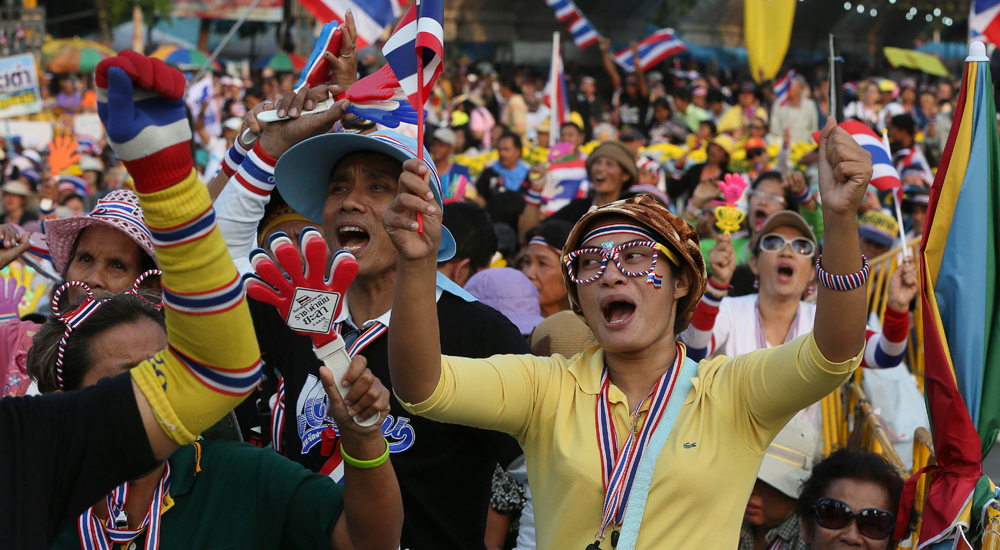
Today’s anti-democracy protestors, many of whom are well-intentioned people drawn from the middle class.
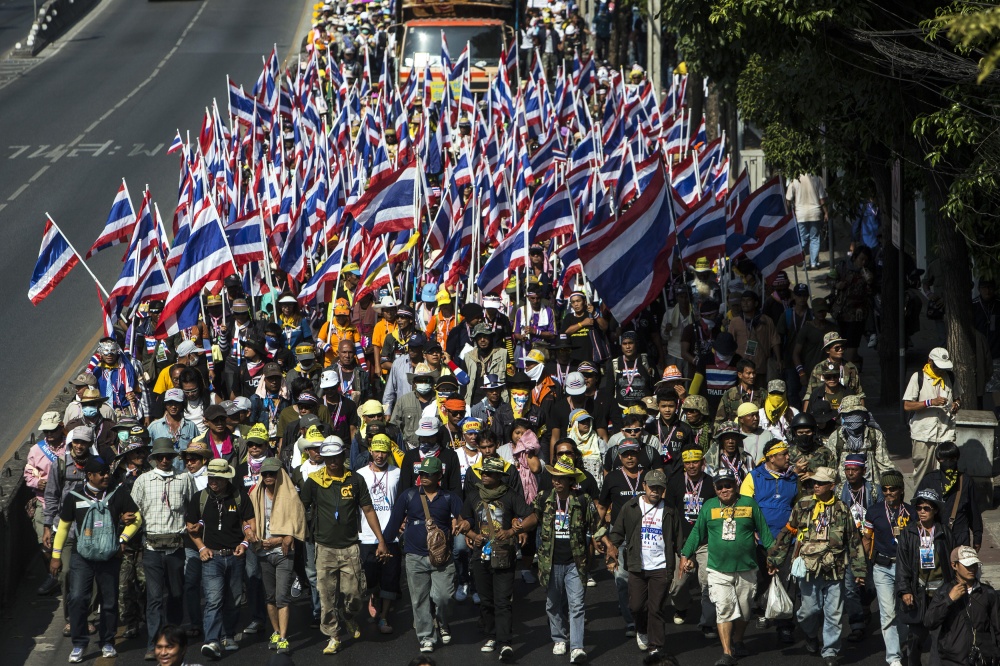
Nationalism is one of the most visible elements of the current protests, with the red white and blue of the Thai flag replacing yellow as the predominant color scheme.
Sopranzetti, in his time at the red shirt occupation itself, confronted the same question. Days before the military moved in, he ran into a young, middle-class student from a yellow shirt family who had come to see for herself why people were protesting. In their conversation, the same question is raised in a different form:
How do we make sense of people thinking that red shirts deserve to die at the hands of the army? […] The question becomes for her how a “good person,” a moderate member of society, comes to think that the state has the right, or rather the duty, to kill people for disrupting life in a commercial area of the city? Or, to put it in the way our friends who side with the military would, how is it that a “peaceful nation under an excellent genius king” comes to be so divided? (pp. 118-119)
Earlier on, seeing the red shirts face off against the military, the division had been equally clear:
Eye to eye, not just soldiers and red shirts, but two faces of Thailand, two different ways of conceiving the role of citizen and social being. On one side, an idea of social responsibility and citizenship that stresses order, respect for a chain of command, and compassion and generosity towards the state and its leaders, who are there for everybody’s good. Such a citizen wais to the soldiers, brings them food and drinks phuea chat, for the nation, to celebrate and support its brave defenders. On the other side, an idea of citizenship based on participation, watching closely the state and its governors, of being Thai and working for the good of the nation, phuea chat, by revolting against a system perceived as unjust and to be changed “for the future of the country,” as an old man said today, almost spitting it out through his front teeth. These two Thailands are today silently facing each other across Rama IV Road, both armed with conviction, certain of being in the right, but carrying different weapons—sticks and slingshots against steel tools of war. (pp. 61-62)
This is more than the rise of a far-right movement out of the failure of some watered-down populist momentum. It’s a phenomenon of increasing social polarization, with a right-wing cohering against a left-wing, both of which have significant roots among the population and both of which lay claim to the support of “the people” as such.
But if populism is the natural ecosystem of the right-wing movement, it’s a hostile environment for the left. Whereas the far-right in Thailand is able to feed off the ambient populism to greater and greater degrees as time goes on, the left, and the far-left in particular, will become increasingly feeble insofar as it remains populist in character. Yingluck’s betrayal of the left faction of the Red Shirts (many of whom, like Surachai, remain in jail and could, potentially, face the death penalty after a coup), attempts to solidify this populist base—essentially guaranteeing that her administration will, in the long term, either foster a right-wing opposition or incorporate this right-wing into a new political order. A victory for “the people” themselves is prevented in either scenario.
The Party
This process of social division is the emergence of the historical party out of the era of riots, a phenomenon that has been produced here by the particular class dynamics in Thailand after the financial crisis of the late nineties. The party is, in its most basic sense, the act of taking sides. It is when members of a given society are forced to become increasingly partisan—when poles form between the “Party of Order” and the “Party of Anarchy” to use Marx’s famous image from the Eighteenth Brumaire. As Gavin Walker has recently argued[17]: “The party does not mean a program or line. It means the organizational mode that crystallizes a choice […]” The emergence of the historical party is then the emergence of this division itself, a division that cuts through a society so deeply that all “spontaneous” organization and protest, despite its particular character or issue, must increasingly side with one or the other. In this case: yellow or red.
Walker claims that this historical party is the party, an alternative to the particular organizational lineage of the 20th century communist movement, though one hinted at and tacitly endorsed by Marx himself. In opposition to this, Jason Smith has argued that “for Marx, there is no question of another, alternative form of the party. There is a single party, polarized around two moments […]” In other words, the historical party is
one moment in a dynamic articulation, a pole in an unpredictably modulating relation between punctual, “episodic” crystallizations of the formal party—with its formal separation from the class, membership, internal discipline, etc.—and the underground unbroken current of the historical party, gathering in its wake all of those communist “partisans” (to use Walker’s word) called to accomplish the historical task of carrying out the communist revolution
Walker either sees no difference between the “formal” and historical party, or he argues that the historical party is sufficient unto itself and, more importantly, opposed to the formal party, whereas Smith, in a way, repeats the basic observation of Amadeo Bordiga, leader of the Italian Communist Party in its heyday (emphasis below is mine):
Marx says: party in its historical meaning, in the historical sense, and formal, or ephemeral, party. In the first concept lies the continuity, and from it we have derived our characteristic thesis of the invariance of doctrine since its formulation by Marx; not as the invention of a genius, but as the discovery of a result of human evolution. But the two concepts are not metaphysically opposite, and it would be silly to express them by the poor doctrine: I turn my back on the formal party, as I go towards the historical one.
When from the invariant doctrine we draw the conclusion that the revolutionary victory of the working class can only be achieved with the class party and its dictatorship; when, on the basis of Marx’s words we maintain that without a revolutionary and communist party, the proletariat may be a class for bourgeois science, but it is not for us and Marx himself; then the conclusion to be deduced is that, in order to achieve victory, it will be necessary to have a party, worthy at the same time of both characteristics, those of historical party and formal party, i.e. to have solved in the reality of action and history the apparent contradiction – that dominated a long and difficult past – between historical party, then as far as the content (historical, invariant programme) is concerned, and contingent party, that is relating to the form, operating as a force and a physical praxis of a decisive part of the struggling proletariat.
The historical party, as the emergence of a fundamental division, forces members of a society to make a choice. In making their choice, red or yellow, many then engage (some actively, some from a distance) in the building of certain formal, coordinating bodies that exist within and stretch across the body of the historical party. The historical party generates from itself the formal party, which Bordiga also calls the contingent or ephemeral party. In his schema, the historical party relates to the content, which is the historical, invariant programme of communism foreboded in the era of riots (the “spectre” itself), while the formal party relates, exactly, to form, which is also to say that it has a certain contingency, since this form is determined by an array of functions or “physical praxis,” dictated by the political requirements of history.
But the process does not stop there. In the next upsurge of the historical party (when the left-populist energies of the early 2000s returned in late 2000s to fight the new dictatorship, for example), the formal parties produced in the last upsurge enter into the historical party both as its organs of institutional memory—as, very literally, the embodiment of history reborn—and as poles of discipline capable of coordinating, cohering, extending and deepening the dynamics of the next social upsurge from an early point in its trajectory.
Meanwhile, these formal parties are again reforged through new contact with the historical party. They are again submerged in the embers of the class war from which they first emerged. Many, having become decrepit, corrupt or inflexible, will simply be destroyed and their components, in the form of individual partisans and disciplined militants, incorporated into new formal parties—or these individuals will become apostates, abandoning the historical party itself and seeking its suppression. Other formal parties will emerge sharpened, magnetic, capable of doing more damage and attracting more of the partisan population to their ends. If successful, this means the fusion and overcoming of existing forms of organization into an explicitly communist project. In other words, the party would dissolve the populism internal to it, qualitatively changing the meaning of “the people” as agent and referent of revolutionary activity.
As Endnotes argues in “Spontaneity, Mediation, Rupture:”
The party cleaves its way through proletarian organisations […] The difference between organisations and the party is, therefore, the difference between, on the one hand, committees of the unemployed, neighbourhood assemblies and rank-and-file unions—which organize the disruption of capitalist social relations—and on the other hand groups of partisans—who reconfigure networks of transportation and communication and reorganize the creation and free distribution of goods and services. Communist tactics destroy the very distinctions (e.g. between employed and unemployed on which proletarian organisations are based. (p. 240)
This distinction holds both for the historical party and the formal party, which is not the same as, nor reducible to, proletarian organizations. The formal party only exists as the consolidation of the historical party’s fundamental rejection of the current system—it cannot take the simple form of a proletarian organization constructed around a given identity and capable of making demands of the state for its constituents. It is, like the historical party, fundamentally demandless, because what both demand is the basic destruction of the very powers that are the target of demands. Formal parties can, however, degenerate into simple proletarian organizations, turning into useless reformist appendages of the existing state, at which point they cease to be parties.
But neither Walker, nor Smith nor Endnotes explore what happens when the historical party seems to generate and consolidate formal “Parties of Order,” oriented inherently toward the right and directed against the historical party itself—with its communist invariants—while at the same time throwing the “Party of Anarchy” (i.e., the nascent Communist Party) into disarray.
In Thailand this has taken the form of both a military defeat (in 2010), and a Thermidorean reaction (in the form of Yingluck), with the result now being that the only consolidated, formal parties remaining with any substantial strength are either center-right or far-right in character—including Yingluck’s Pheu Thai and the remnants of the UDD. At the moment, only such conservative forces can be said to act as functional organs of institutional memory for the historical party, and they are the only disciplined poles capable of coordinating, cohering, extending and deepening the action of the people as such.
So what has happened? The communist philosopher Alain Badiou offers some helpful insight. Badiou recognizes that a political “event,” such as the 2010 occupation of Bangkok, does in fact generate a certain “subjectivity” relative to it. In other words, the emergence of the historical party (also the “rebirth of history” in Badiou’s own terms) implies that processes of formalization are initiated—and that this formality, though functional and contingent (per Bordiga), is also retroactive, in the sense that it fundamentally defines itself through its relation to an “event” that has already passed, while also re-defining (or, as we will see, foreclosing or obscuring) that event itself through action in the present.
For Badiou, there are three types of subjectivity: faithful, reactionary and obscure. The faithful subject constructs the true (similar to Bordiga’s “invariant programme” of communism) by maintaining “fidelity” to the event. This is done through the confrontation and overcoming of certain “points” of decision, often material limits to the struggle that come in the form of repression or key choices about the future of a political project.
In our terms, we could say that the faithful subject covers the “formal parties” developed out of the historical party, which Marx, mocking the bourgeois press of the time, termed the “Party of Anarchy.” These are organized bodies that seek to preserve, consolidate, develop and extend the communist potentials embedded within the mass movement itself, which is, again, the rebirth of history—this is true whether or not these bodies call themselves a “party,” or even think of themselves as an “organization,” though some act of naming is necessary. Judging the situation from a distance, it appears that, in 2010 and its aftermath, the forces in and around Red Siam most visibly played the role of the faithful subject. Now that Red Siam has been crippled, it’s unclear who might fill this role—as foreign observers, the best we can do at the moment is hope that forces invisible to us are currently in motion, reconstituting the body of the faithful subject as bearer of the communist project in the face of another potential coup.
The reactionary subject, in Badiou’s terms, recognizes the event but opposes it. This subject attempts to deny and foreclose the evental opening, to suffocate its communist potential and to “return to normal,” which really means the forcible implementation of capitalist discipline on a population that has seen, if only briefly, the horizon that sits beyond capitalism’s morbid, atonal world. Normally the role of reaction is filled by the state, the police, the military, etc.
This, nonetheless, involves a recognition of the event, since the subject necessarily reacts to it. As Badiou explains:
In order to resist the call of the new, it is still necessary to create arguments of resistance appropriate to the novelty itself […] It is not a pure negation of the evental trace, since it also claims to produce something—and even, frequently under the cloak of modernity, to produce some kind of present […] It is a measured present, a present ‘a little less worse’ than the past, if only because it resisted the catastrophic temptation which the reactive subject declares is contained in the event (Logics of Worlds, pp. 54, 55).
But in the case of Thailand, the reactionary subject was Thermidorean in nature. As we’ve examined above, it was actually Yingluck, alongside the right-wing of the UDD, who played this role, ultimately seeking a Thailand ‘a little less worse’ than that represented by the military junta. They left the bulk of the Red Shirt leadership in prison and charged Surachai with insulting the king, thereby beheading Red Siam (Giles Ji Ungpakorn, another key Red Siam supporter, had already fled the country after the original coup). Though recognizing the political event itself—and in fact being propelled into power by it—Yingluck’s government has since sought nothing but the restoration of normalcy, continuing the corporatist development programs of the Thaksin era (including an enormous rice subsidy aimed at satiating the peasantry) and seeking the further integration of Thailand into global capitalist logistics networks.
In our terms, we can say that the reactionary subject is the formation of “parties of order” directed at defeating and dismantling any formal parties that have arisen from the rebirth of history and at suppressing the historical party itself. Such a party of order almost always takes a state form—whether this be in the shape of a liberal democracy, a “socialist republic” or a warlord fiefdom. In so doing, the parties of order necessarily recognize the formal party (“the party of anarchy”) and the historical party (the mass movement, the outburst of riots, strikes, collective acts of occupation and expropriation). These are posed as its counterforce, and, in many scenarios, they may be strengthened by such naming.
In contrast to both the faithful and reactionary subjects, the obscure subject does not even properly recognize the event or the subject faithful to it. As the name suggests, it simply attempts to obscure the event as such and to eliminate any trace of it, including the revolutionary “body” of the faithful subject. Whereas the reactionary subject “denies” the event through opposition, the obscure subject “occults” it through the generation of a mystical, ahistorical unity that dissolves the present into the mythic image of some lost, prelapsarian past. In Badiou’s words, the obscure subject
Systematically resorts to the invocation of a full and pure transcendent Body, an ahistorical or anti-evental body (City, God, Race…) from which it follows that the trace will be denied (here, the labour of the reactive subject is useful to the obscure subject) and, as a consequence, the real body will also be suppressed.
[…]
the obscure subject offers the chance of a new destiny, under the incomprehensible but salvific sign of an absolute body, whose only demand is that one serves it by nurturing everywhere and at all times the hatred of every living thought, every transparent language and every uncertain becoming (pp. 59-60, 61)
The anti-democracy protestors, and the right-wing populism they are a part of, today fill the role of the obscure subject. This populism precisely invokes “a full and pure transcendent Body” in the form of the Thai nation, united by king and religion. It reaches back into an imagined past to construct the racial agrarian myth popular among “radical” intelligentsia and fundamentalist sects such as Santi Asoke and Pitak Siam. Meanwhile, it stands in violent opposition to the reactive and faithful subjects, since both in their own ways recognize the event itself and seek to construct a new political present.
In the terms established above, then, we have to recognize that the anti-democracy protestors are not simply “the party of order,” contra the “party of anarchy.” In fact, the “party of order,” represented here by Yingluck and the liberal-democratic capitalist factions she represents, sees the obscure subject as itself fundamentally “terrorist,” and very much a part of what it perceives to be “the party of anarchy.” There is some truth to this, as the obscure subject does not, at least initially, have to take a state form—it can be earnestly anti-state, especially when it affirms a religious order against a secular one. In traditional liberal fashion, the party of order mushes together the far-right and the far-left until they appear to be nothing but a vague, terrorist “totalitarianism” evacuated of all sense or reason.
In contrast to the “party of order” and the “formal party” (or “party of anarchy”), then, the obscure subject can be thought of as simply the “anti-party,” imagining itself “beyond left and right.” Its ultimate political practice is to destroy every vestige of the present in the name of an “incomprehensible” and “salvific” unity, justified by a mythic past. When in power, the anti-party can generate nothing but warlordism or a dry technocracy gilded in religion, war and spectacle. Its mode of rule is, by necessity, military and religious, though even its state forms can be administered in a quasi-stateless fashion at the lowest levels through a combination of indoctrination, self-organization and mercenary force wielded by local gentry.
In Thailand, as in Italy and Ukraine, we have been observing the rise of such anti-parties. The anti-party, in practice, seeks to liquidate both the party of order and the party of anarchy. But this isn’t all. Since it occults the historical party itself, the anti-party aims to very literally end history by burning the books, burying the scholars and turning the clock to “year zero.” It destroys the potential raised by the historical party and obscures the “communist invariants” that arise from that party’s motion. It is a fundamentally destructive, fundamentally sacrificial procedure. Yet it is precisely the anti-party that is now the enemy in ascendance.
The Obscure Enemy
Today’s anti-party feeds off the populist dynamics generated by our era of austerity. The “age of riots,” like those of previous generations, is not inherently communist, though it contains the potential for a communist project—in such an era, these communist invariants appear as “spectral,” haunting the riot from its fringes rather than acting as its driving, organizing force.
At the same time, the old solutions no longer offer us much help. The new right-wing has become skilled at consuming and incorporating the most useful components of the last few decades’ dead left-wing movements—many of these far-right groups actually clothe themselves in the aesthetics, theory and, to a limited extent, the practice, of autonomy, decolonization, and anarchism. Formal parties from eras past have been decomposed and reincorporated into today’s anti-party, often following the rightward drift (even if unacknowledged) of many leftist intellectuals over the same time period.
Bratstvo are Christian orthodox national anarchists, CasaPound founds squatted social centers and fights the police to defend them, Santi Asoke runs autonomous rural communes, has a national network of co-operatives and talks of “decolonization” in much the same way as west-coast anarchists here in the US. All of these groups portray themselves as “neither” left nor right, or “beyond” left and right. Meanwhile, their post-left, post-Marxist aesthetic and post-colonial intellectual treatises act as a veil covering a fundamentally far-right ideology and deeply conservative political practice. Similarly, all invoke a mythic “community” to be found in tradition and regained through moral discipline, accompanied by the absolute destruction of all who oppose this “mystical unity,” whatever form it might take.
In the case of Thailand, the danger is clear. As Marc Saxer has argued in a recent intervention on New Mandala covering the current anti-democracy protests:
In Thailand, the symbolic struggle over the role of the monarchy threatens those who base their identities in the traditional order. Conservatives interpret challenges to the traditional order not as calls to build a better society, but as threats to their way of life. Mistakenly or not, these fears seemed to have been validated when several shopping malls in the center of Bangkok were torched in the course of the crackdown against the red shirt demonstrations in May 2010. Located near “Siam Square”, in the eyes of Bangkokians the center of the country, conservatives’ worst nightmares seemed to come true: “the buffalos have burned down the City of Angels”. This traumatic event was interpreted as another ominous sign that “Thai society is in decay”.
[…]
If European history is any lesson, middle class angst and anger can be fertile breeding grounds for fascism. Against the vertigo of change, fascism promises to restore unity and order. The “disease of plurality” must be healed by uniformity. ‘The Other’ outside and inside must be “rooted out” to heal the societal body. Those who are framed as “The Enemy Within” were being dehumanized, threatened to leave the country, verbally attacked and physically destroyed. Internal conflicts were exported by constantly blaming and attacking outsiders. As this cannot be done without violence, fascism idealizes the use of force, and glorifies the purification through war.
Contrasting the “decay” of the present against an imagined golden past, fascist movements aim to turn back the wheel of history. The fascist utopia is basically the anti-thesis to the modern, pluralist and capitalist society. Fascism seeks to overcome the divisions of a fragmented society and the noise of a pluralist culture by melting all differences into a homogeneous, “people’s community”. The trinity of “One Nation, One People, One Leader” aims to purge the chaotic plurality of the industrial society and return to the mythical unity and simplicity of the “agricultural community”.
Similar warnings could be written for Ukraine or Italy. And, if US-based communists fail to cohere any formal structure out of our experience in Occupy (or whatever comes next), we will likely find ourselves in a similar holding pattern, strung between progressive social democracy and a resurgent right-wing populism that this time (contra the Tea Party experience) stands a chance at extending well into our own demographic and generational strongholds. Though at the moment marginal, with the correct combination of crisis, contingency, financing and rebranding, today’s wingnuts could soon find themselves at the forefront of dangerous mass movements backed by particular factions of the corporate elite.
The recent petty coup of Justine Tunney, another “co-founder” of Occupy Wall Street, speaks to the danger here. In early February, Tunney, a former anarchist in OWS who since got a job at Google, took control of the “official” OWS Twitter in order to post rants against welfare and argue that poverty is not a political issue but rather “an engineering problem,” alongside other such techie-libertarian garbage. More disconcertingly, Tunney used the OWS twitter to call for the crowdfunding of an anarcho-corporate “occupy militia,” designed to recruit people and pay them to protest a given issue.
Though laughable at the moment, Tunney’s actions actually signal the frightening possibility of a directly politicized, far-right populism of a different form than we might expect, backed by a particular fraction of the US ruling class—the infotech sector and attached industries, concentrated on the West Coast in cities like Seattle and San Francisco.[18] This populism would take on a techie-leftist branding, its denizens already flocking to Burning Man every year to engage in what has become little more than an upscale corporate retreat, and would likely include targeted expansions of quasi-socialist welfare programs in particular “creative class” urban enclaves. This would entail some degree of fusion with US progressivism, particularly the leftovers of the anti-globalization era (the “99ers,” many of whom went on to become the right-wing of Occupy), now distributed across NGOs, universities, municipal governments and union bureaucracies.
At the same time, it’s just such forces that have been behind the rapidly skyrocketing cost of living in these coastal metropolises, often toting with them a very polite, tacit variant of white supremacy, converting urban cores into zones of “light diversity,” as families are deported, evicted and otherwise forced out to suburban rings of “high diversity,” to repeat the race-neutral language of today’s brutal systems of racial domination. Similarly, their focus on forms of “non-state” direct-democracy-through-technology pays little mind to who can afford regular internet access in the first place, much less the hardware needed to participate in such an online agora or, heaven forbid, the 农民工 soldering it all together.
Such a scenario is highly speculative, and simply one of many variations on a theme. The point is less that we need to be particularly afraid of our friendly neighborhood wingnuts, like Micah White or Justine Tunney, and more that such seemingly “left-right” syntheses are not only possible, but probable, given the slow deepening of the crisis and the long stretch of austerity ahead, punctuated, possibly, by a collapse in Asia, Mexico or the Eurozone that could plummet certain segments of the US into a new depression. And these syntheses will not necessarily arise from the “usual suspects.” Any reactionary movement with real purchase in the US will not be based, like the Tea Party, among the predominantly conservative white Baby Boomers, though they will likely guide its trajectory. If either history or current events are any indication, such an enemy will emerge much closer to home, very much sharing its social base with any potential communist movement.
Standing Still
The worst possible conclusion to draw from all this would be presume inevitability. Yes, the forces of the right are globally resurgent—but their success is neither unchallenged nor guaranteed. Even in Ukraine, an actual insurrection or civil war could unsettle these terms by setting hundreds of thousands of new partisans into motion and thereby transforming the basic dynamics of the movement. In Thailand, a successful coup could mean a re-occupation of Bangkok by the Red Shirts who, by every indicator, hold the majority of support—both in absolute terms and among the nation’s poorest residents. Rampant inflation, combined with structural problems in the government’s rice subsidy, could also push a new Red Shirt resurgence away from Yingluck, even as it opposes the yellows, the military and the monarchy.
These movements represent, then, not the dismantling or final suppression of the historical party, but instead its solstice. Derived in part from the Latin sistere, meaning “to stand still,” solstice implies the apparent freezing of momentum as the sun reaches a trough or a precipice in its annual cycle, standing still in declination, after which its seasonal direction reverses. It is the longest night in winter, but still a night followed by day in a freezing season followed by the thaw.
The movements outlined above very much seek “to stand still.” They advocate orthodoxy, stability, and tradition against both dissolving effects of global capitalism and the specter of liberation foreboded in the era of riots. But such stability is an illusion. The only order they can offer is one guaranteed by immense violence and systematic exclusion. If they are allowed to take power unchallenged by the left, the face of the insurrection will be irredeemably bloodied in the eyes of many. And in some places the insurrection may well be the terrain on which they will have to be confronted.
The point of all this is not, then, to simply bemoan our condition. The solstice is a sharp precipice. It is a fulcrum capable of amplifying any pressure applied, to the left or to the right—and the pressure itself determines the direction that itinerant force will tend to slide. The worst possible response would be retreat. This is especially true in the US, where the right has yet to consolidate and the danger lies in a premature dismissal of the threat. Today, the obscure enemy may well stand at our shoulder. Tomorrow, it might command the barricades that we ourselves have built.
The only real option for us, then, is to apply a counterforce, because the cycles of our era are by no means natural. The sequence of these strange seasons is not guaranteed. When the light sits in the trough of its solstice, it must be forced to rise. In the depth of winter, we must light fires.
[1] See: Shekhovstov, Anton, “Para-Militarism to Radical Right-Wing Populism: The Rise of the Ukrainian Far-Right Party Svoboda.” In Wodak, Ruth, Majid KhosraviNik and Brigitte Mral, Eds. Right-Wing Populism in Europe: Politics and Discourse. Bloomsbury Academic. 2013. pp. 249-263.
[2] Ferrara, Federico. Thailand Unhinged. Equinox Publishing, 2010. pp. 145-146.
[3] For more information on the Assembly of the Poor, see: Missingham, Bruce D. The Assembly of the Poor in Thailand: From Local Struggles to National Protest Movement. Silkworm Books, Chiang Mai, Thailand. 2003. And: Chalermsripinyorat, Rungrawee, “Politics of Representation: A Case Study of Thailand’s Assembly of the Poor.” Critical Asian Studies, Volume 34, Number 4, 2004. pp. 541-566.
[4] For more detail, see: K.Hewison, “Thaksin Shinawatra and the reshaping of Thai politics”, Contemporary Politics, Volume 16, Number 2 (2010), pp. 119-33.
As well as: de Jong, Edwin, Luuk Knippenberg, Dusaee Ayuwat and Buapun Promphakping, “Red-Shirt Heartland: Village-Level Socioeconomic Change in Northeast Thailand Between 1999 and 2008,” Asian Politics & Policy, Volume 4, Number 2 (2012). pp. 213-231.
And: Glassman, Jim, “Economic ‘Nationalism’ in a Post-Nationalist Era: The Political Economy of Economic Policy in Post-Crisis Thailand.” Critical Asian Studies 36:1 (2004). pp.37-64.
[5] The following timeline is constructed from the events described firsthand by Claudio Sopranzetti, in his blog “The Drop,” particularly the entries from April 2010 to February 2011, and his subsequent book Red Journeys: Inside the Thai Red-Shirt Movement, Chiang Mai: Silkworm Books, 2012. A spare few missing dates and numbers are taken from relevant citations on the “2010 Thai political protests” Wikipedia page.
[6] Despite hype by the media and particularly vocal cliques of academic autonomists, though, none of these features are at all unique to struggles of the past decade or even the information era. In fact, similar images seem to mark almost all popular uprisings, particularly the more “spontaneous” ones that do not develop (or retain from previous uprisings) more organized bodies ready to coordinate, intensify and extend the movement beyond its immediate terrain. Such features were as common in the Paris Commune as they were in 1989, and are arguably rooted in certain invariant dimensions of mass uprising, since similar characteristics have been noted in millenarian uprisings in medieval Europe, throughout the history of Upland Southeast Asia, and in myriad anti-colonial struggles.
[7] Pridi Banomyong was the founder of Thailand’s People’s Party, which led the Siamese Revolution of 1932, ending 150 years of absolute monarchy and instituting a parliamentary socialist-leaning democracy in its place. Pridi was then overthrown by conservative nationalists in the army and went into exile, before returning to found Thammasat University and lead the Free Thai Movement against the Japanese in World War Two. Though victorious, his faction was again ousted by a military dictatorship. After a failed attempt at pro-democracy coup against the dictatorship, Pridi fled to China and then France, where he lived out the rest of his life.
[8] Note that Ji Ungpakorn uses a non-traditional transliteration system intended to communicate the correct pronunciations to a Western audience. This has the unfortunate side-effect of making many names difficult to Google. I have instead used the standard transliteration system, which accounts for the periodic differences in spelling.
[9] Chamlong was governor of Bangkok in the late ‘80s and early ‘90s.
[10] Winichaul, Thongchai. “Nationalism and the Radical Intelligentsia in Thailand,” Third World Quarterly, Volume 29, Issue 3 (2008). pp. 575-591.
[11] The work of Chatthip and his followers is steeped in language drawn from the likes of Guha, Chatterjee and Spivak, and many consider themselves to be within the subalternist school of post-colonial theory. This is, nonetheless, still a somewhat simplified picture excluding much of the detail and ambiguity in Chatthip’s own work and the (often qualified) support of it by other academics. For more detail, see the book: Phongpaichit, Pasuk and Chris Baker (eds), Essays on Thailand’s Economy and Society: For Professor Chatthip Nartsupah at 72, Sangsan, Bangkok, Thailand, (2013). The first article is available for free here: <http://www.academia.edu/4436395/Chatthip_Nartsupha_His_Critics_and_More_Criticism>
[12] For more on the general concept of the “agrarian myth” see: Brass, Tom. Peasants, Populism and Postmodernism: The Return of the Agrarian Myth. Routledge, (2000).
[13] Dayley, Robert. “Thailand’s Agrarian Myth and its Proponents,” Journal of Asian and African Studies, Volume 46, Number 2, (2001). pp. 342-360.
[14] The most effective surplus-absorption strategy in the face of such economic crises is arguably offered by the example of China, which uses its hukou (户口 – household registration) system to prevent migrant laborers from gaining access to urban social welfare infrastructure, leaving them dependent instead on the support offered by their home villages, where every family has the right to a plot of land. In the fallout from the 2008 financial crisis, China saw massive lay-offs in its heavily industrialized coastal cities—but this did not generate homeless camps and massive discontent, as it would elsewhere. Instead, many workers, having returned to the countryside for the annual Spring Festival, simply stayed there. For more on this phenomenon, see Chan, Kam Wing, “A China Paradox: Migrant Labor Shortage amidst Rural Labor Supply Abundance,” Eurasian Geography and Economics, 51:4, (2010). pp. 357-364.
[15] For the full story, see: “The good old days,” The Nation. November 30, 2005. <http://www.nationmultimedia.com/specials/sondhi/nov30.php>
[16] To take one example, we can see the continued development of the Mae Sot Thai-Burmese border-region SEZ throughout the late 2000s: Arnold, Dennis and John Pickles, “Global Work, Surplus Labor, and the Precarious Economies of the Border,” Antipode, 43:5. pp. 1598-1624.
[17] The essays by Gavin Walker and Jason Smith referenced here were both contributions to a special issue of Theory and Event (Vol 16, Issue 4, 2013), edited by Jodi Dean. The entire issue is accessible for free here: <http://muse.jhu.edu/journals/theory_and_event/toc/tae.16.4.html>
[18] It’s worthwhile to note here that Thaksin and the other business elites who survived the Asian crisis were themselves concentrated in information technology and telecommunications industries. Italy’s Five Star Movement (M5S) also combines similar elements, with Gianroberto Casaleggio, co-founder of M5S, coming from just such a corporate techie background. The party’s actual programs are marked by a techno-libertarianism almost identical to that advocated by former OWSers like Tunney and Micah White. For more on this connection, see Casaleggio’s creepy 2007 video manifesto, Gaia: The Future of Politics, here: <http://youtu.be/sV8MwBXmewU>
—NPC



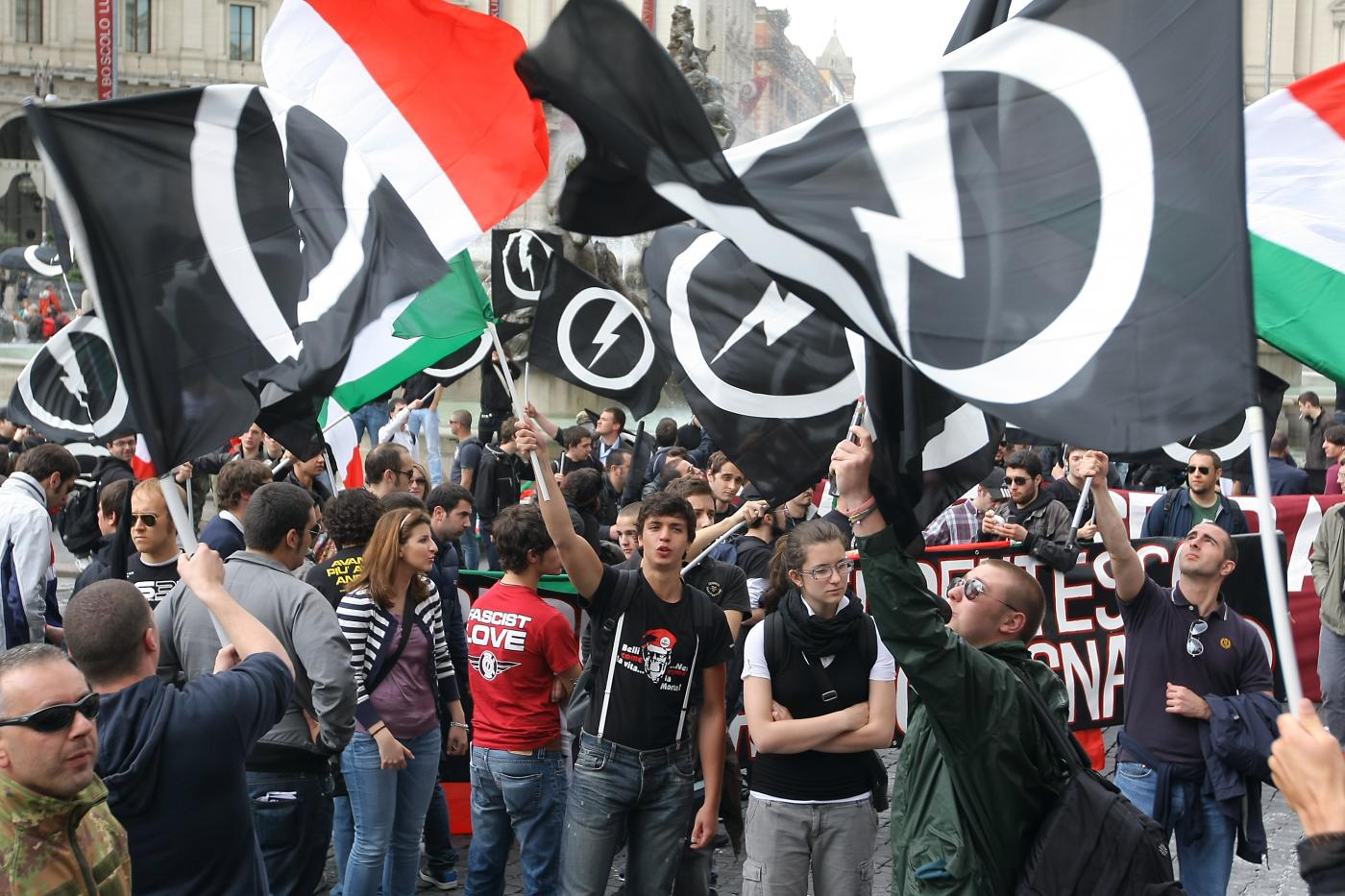
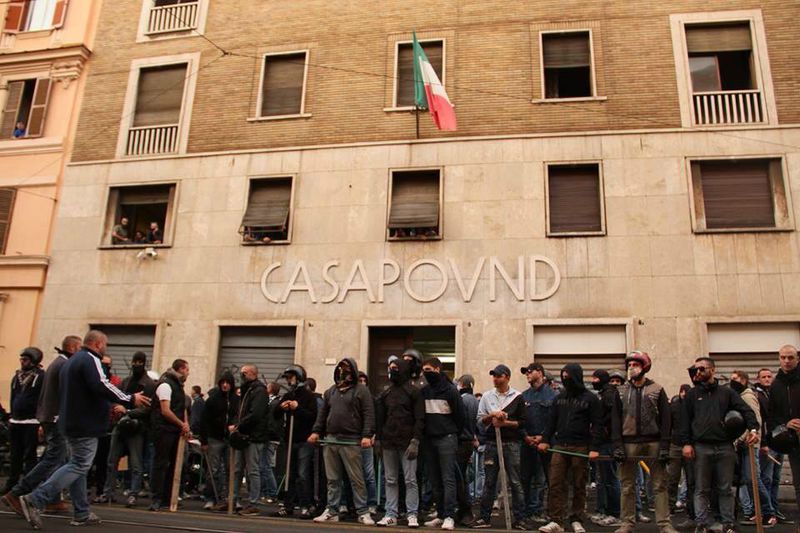
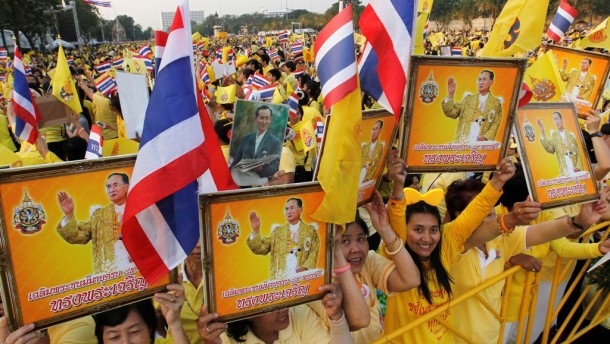
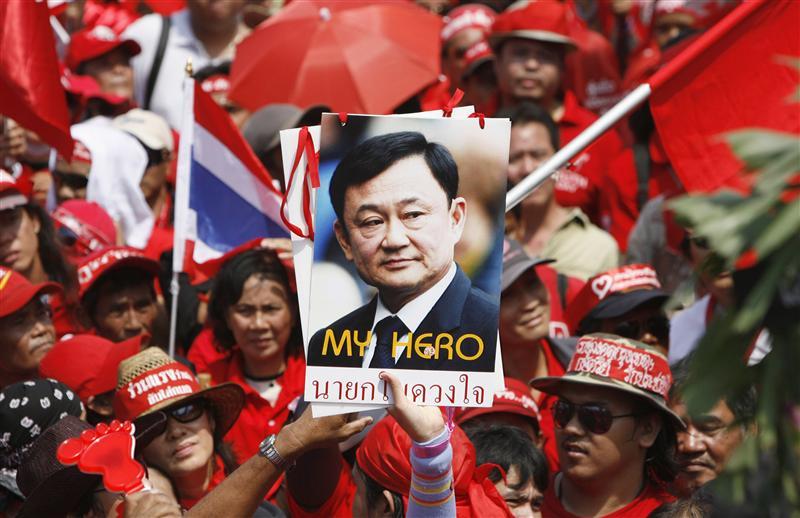
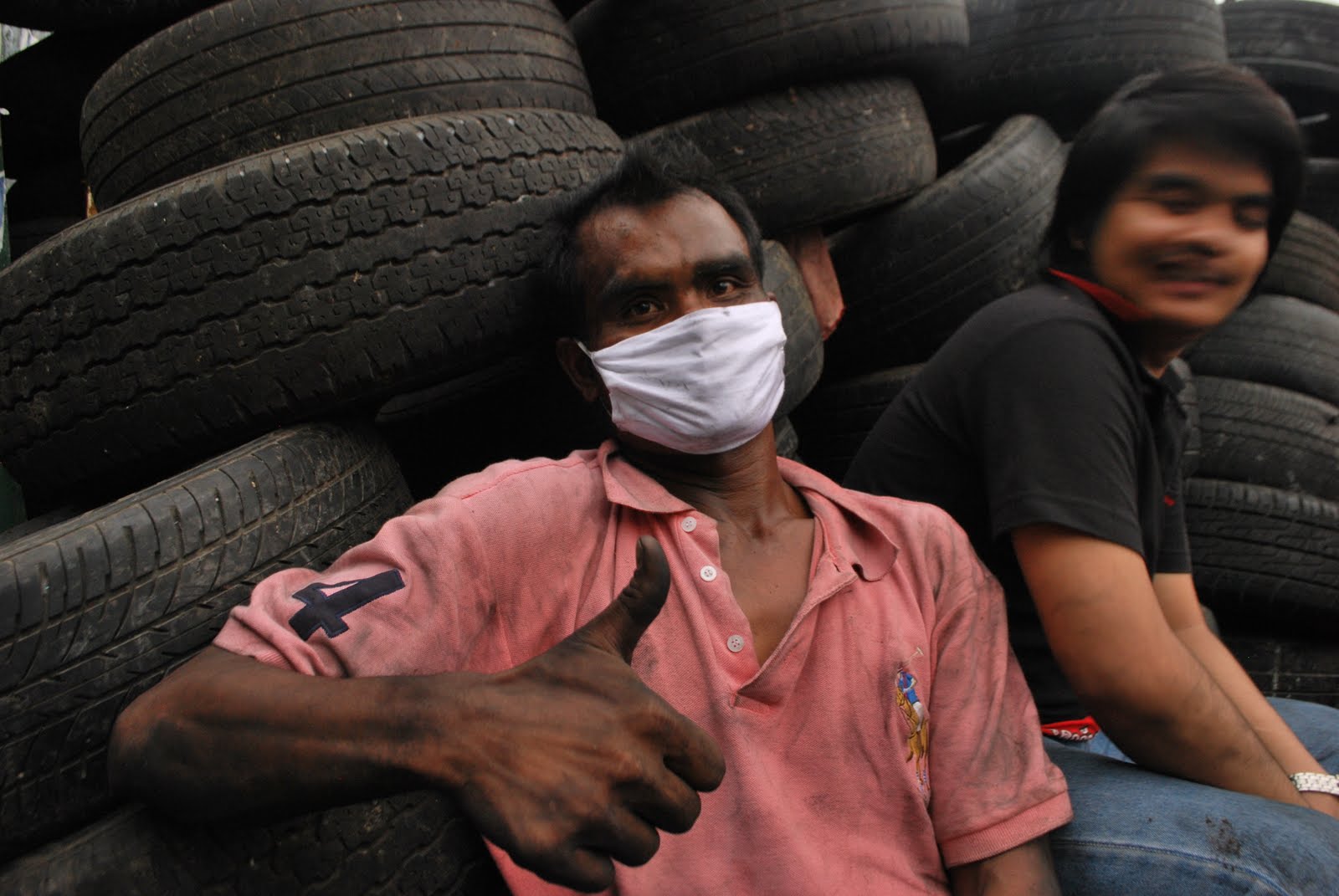
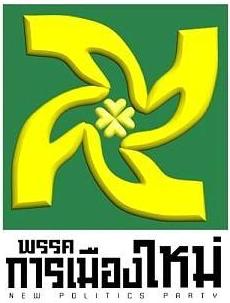
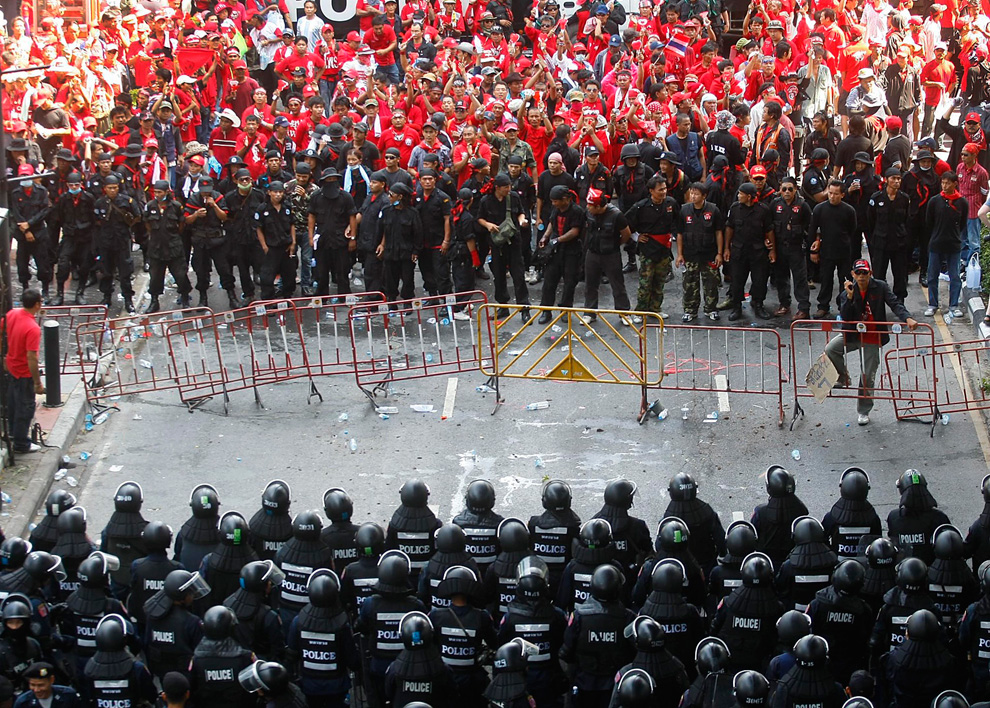
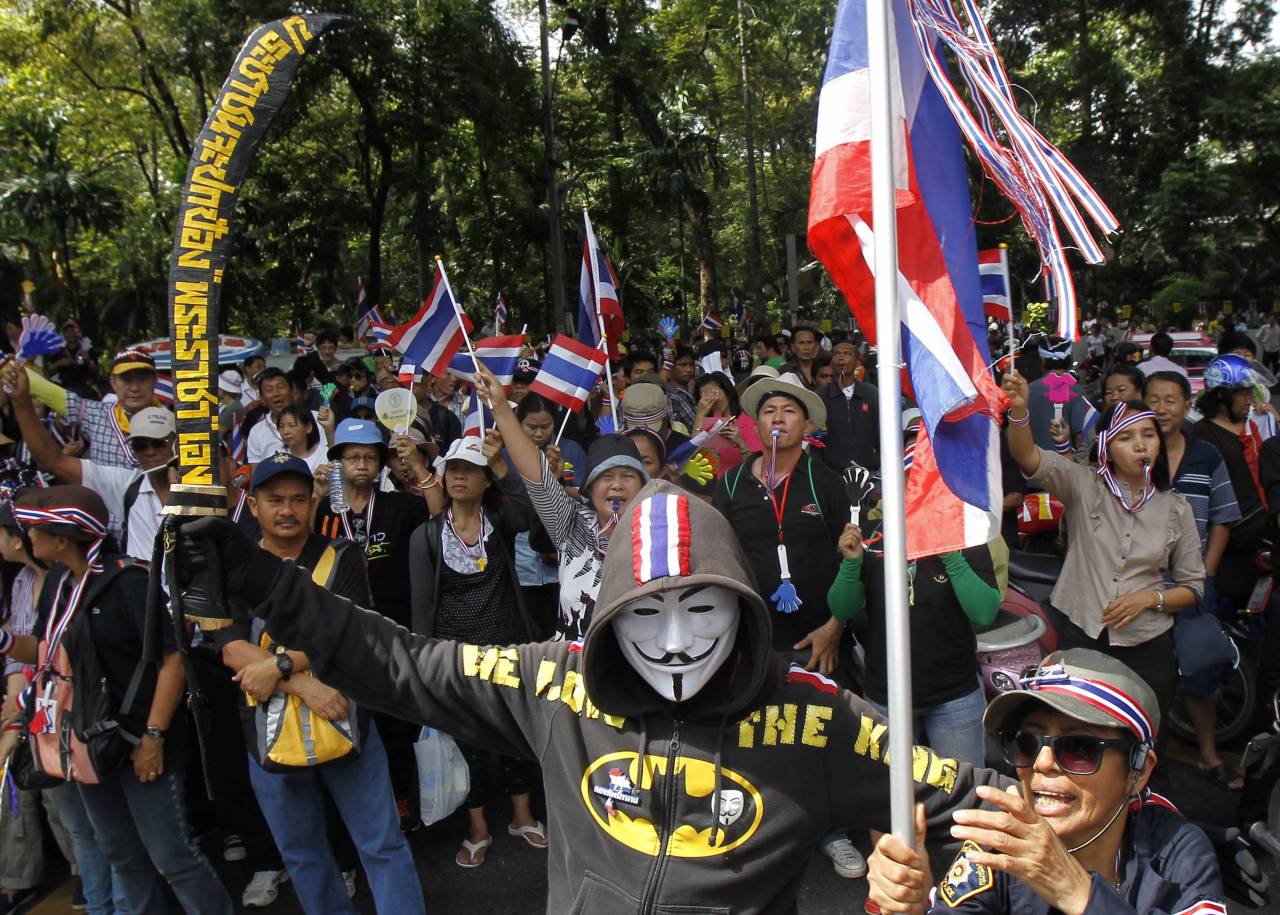
September 23, 2014
A very good, well researched report on the situation in Thailand. I am currently at work on a PhD about the spectacular regime of the king-image, and I found some parts of this work very useful indeed. Will spread the word of your good work and cite accordingly. Good luck and take care,
Dundun.
May 7, 2015
Formatted this text into a printable pdf pamphlet:
https://subversionpress.wordpress.com/2015/04/17/the-solstice-on-the-rise-of-right-wing-mass-movements/
August 12, 2015
Thanks for your insightful analysis. Please publish more on Thailand!